SEO for Travel Websites: A Blueprint for Increasing Rankings & Revenue on the Travel SERPs
June 13, 2024 • 78 min read

SEO has the potential to drive tens, sometimes hundreds, of thousands of sessions for travel brands each month. The opportunities are huge for the sites that get it right and leverage the channel to its full potential.
But the travel SERPs are competitive. Very competitive. And it takes a solid strategy and significant investment to compete.
That said, the ROI of investing in SEO as a travel brand can be huge. Just think, we’re talking bookings with an average value that’s into the thousands of pounds or dollars.
For most travel brands, ignoring SEO isn’t an option. But the strategy that’s going to drive success for an OTA (online travel agent) will be totally different to the one that’s needed for a small, boutique hotel.
And that’s what strategy is all about, right? Planning how to hit the goals you set out.
In this guide, I’m going to walk through what it takes to achieve SEO success as a travel brand. Most of the insights I share are relevant to travel sites as a whole, some more relevant to specific niches than others.
You can think of it as a blueprint to help you to rank your travel website on the SERPs, whether you’re an OTA, a single hotel or even operate a large group of resorts.
You’ll take away a series of insights and learnings from my own work with sites in the travel sector, examples and case studies of sites that are enjoying SEO success and a deep-dive into the tactics that you can go away, implement and see measurable results from.
Keep reading if you want to grow your travel brand’s organic search visibility in 2024.
- SEO: An Opportunity Travel Brands Can’t Ignore
- The Nuances of Travel SEO
- The Helpful Content Update Hit (Some) Travel Sites HARD
- Everything You Need to Know About Ranking a Travel Site on the SERPs
- Keyword Research & Content Strategy for Travel Brands
- Understand the intent of the keywords you target: knowing what type of content ranks
- Building Out a Travel Content Strategy: Essential Page & Content Types
- On-Page SEO
- Topic Clustering & Site Architecture
- Digital PR
- Other Link Building Tactics
- Schema
- E-E-A-T
- Technical SEO
- Optimising for Google Discover as a Travel Brand
- Free Booking Links on Google for Hotels & Holiday Rentals
- Measuring Travel SEO Success
- SEO: A Growth Engine for Travel Websites
- Travel SEO FAQs
SEO: An Opportunity Travel Brands Can’t Ignore
Want to be inspired to double down on SEO as a growth channel this year?
Just look at the non-branded traffic these 10 travel sites enjoy every month.
| Brand | Non-Brand Organic Sessions p/m | Travel Niche |
|---|---|---|
| Travel Republic | 735,590 | Holiday Bookings |
| Sykes Cottages | 695,003 | Accommodation |
| Iglu Cruise | 324,674 | Cruises |
| Audley Travel | 302,804 | Luxury Holidays |
| Hot Tub Hideaways | 269,146 | Accommodation |
| Holiday Hypermarket | 252,696 | Holiday Bookings |
| Mr & Mrs Smith | 248,193 | Accommodation |
| Kuoni | 226,152 | Luxury Holidays |
| Intrepid Travel | 220,881 | Luxury Holidays |
| Sunshine | 214,386 | Holiday Bookings |
Impressive, right?
And that’s without looking at the very biggest brands in the space. I purposefully wanted to show what those travel sites that aren’t quite household names can do.
If we then look at the estimated monthly non-brand organic traffic of some of the largest players in travel SEO, here’s what we see:
| Brand | Non-Brand Organic Sessions p/m | Travel Niche |
|---|---|---|
| Booking.com | 13,112,155 | Accommodation |
| TUI | 5,711,677 | Holiday Bookings |
| Expedia | 4,236,899 | Holiday Bookings |
| Hotels.com | 3,718,327 | Accommodation |
| Kayak | 3,660,327 | Holiday Bookings |
| Thomas Cook | 2,096,476 | Holiday Bookings |
| Jet2 Holidays | 1,949,691 | Holiday Bookings |
| British Airways | 1,586,125 | Flights |
| Lastminute.com | 1,422,444 | Holiday Bookings |
| loveholidays | 1,385,877 | Holiday Bookings |
I’m looking at non-brand traffic here as that levels the playing field a little bit, removing the traffic that’s been influenced directly by brand marketing rather than SEO.
For some travel sites, earning 5% of what some big brands drive through organic search would be business-changing.
The market is there, and it’s your job to determine how to take the largest possible share.
There are opportunities for travel sites of all niches and sizes to perform on the SERPs, and the first thing I want you to take away is that you can outrank these mega brands.
The Nuances of Travel SEO
But before I dive into the tactics you need to leverage for travel SEO success, I want to quickly touch upon some of the nuances seen in this industry.
You see, whilst travel SEO absolutely shares many similarities with SEO for other industries, there are a number of unique challenges you’ll face when trying to rank a travel brand on the SERPs.
You need to be aware of and make sure you’re considering how you’ll respond to these challenges when putting together your growth strategy.
These challenges include:
You’re Competing Against the OTA Giants
Travel is home to some of the most competitive SERPs, especially when directly competing against OTAs.
Go ahead and search for pretty much any keyword around hotels and resorts or flights, for example, and you’re competing against sites like:
- Expedia
- Booking.com
- Hotels.com
- Skyscanner
- Kayak
- Tripadvisor
These are just a few examples of the giants who dominate the travel SERPs, and it’s safe to say that these aren’t just your typical competitors. They’re some of the biggest brands out there, all household names. These brands have been built over many years, not just via SEO but via multiple channels, to get them to where they are today.
I mean, just look at the top 3 organic rankings for ‘hotels in New York’:

The first thing to be aware of in travel SEO is the tough competition. Especially for the high-volume generic keywords.
But that’s not to say you can’t compete against these industry giants. You absolutely can. You just need to figure out how to do it and focus your efforts.
As an example, many specific keywords still have high search volume (but have very strong booking intent) that these sites aren’t ranking for. Why? Because they’re not targeting them, they don’t have pages worth ranking. You need to find these opportunities and leverage them.
You’re Competing Against Google Itself
Not only are you competing against OTA giants for many keywords, but you can also find yourself competing against Google itself.
Take flights, for example.

Google wants to keep you on the SERPs and does this via Google Flights.
You don’t have to click anywhere to see the starting price of flights from your chosen destination or selected dates. And whilst some users want to browse flights how they’re used to (on the airline’s site, on Skyscanner, etc), many will use this feature.
The impact?
A lower organic CTR for the top rankings compared to if this widget wasn’t there. Depending on the travel niche you’re working in, be aware that there are times when Google wants to keep the clicks away from you as much as possible, even if you’re ranking in top spots.
Some SERPs Have a Hotel Pack
Not only can you find yourself competing with Google itself or industry giants, but “hotel” and “‘resort” queries (and variations) usually trigger a hotel pack.
You’re probably familiar with Google’s local pack results that show GMB pages for local searches (e.g. “Indian restaurants in Manchester”), but these travel-related searches show what’s known as a hotel pack.
This results pack shows a number of hotel, resort or accommodation listings in a specific location, with key information such as ratings, prices, star ratings, and more shown as part of these.
Check out the hotel pack when running a search for “hotels in New York”:
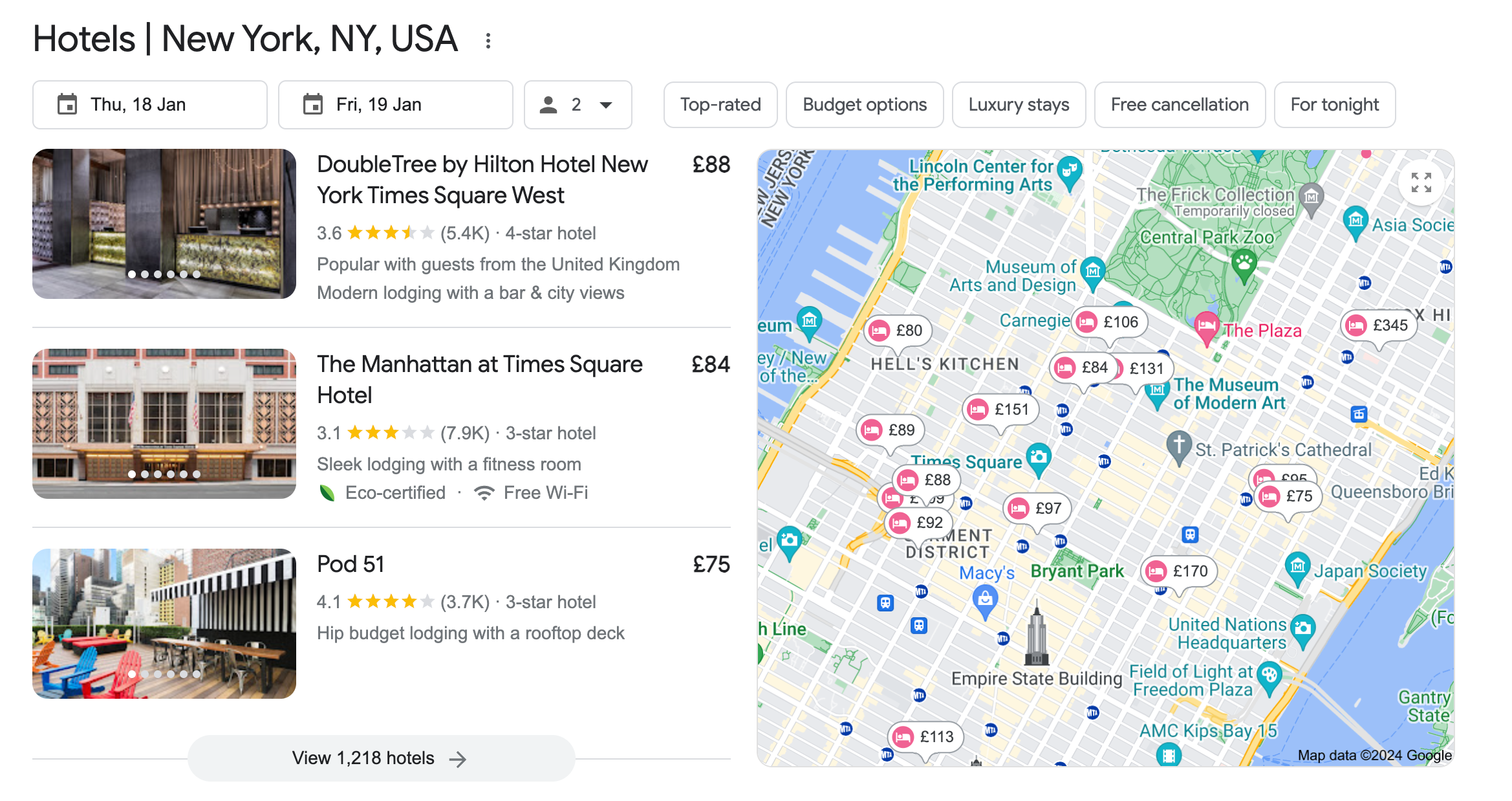
Or the hotel pack for “resorts in Tulum”:
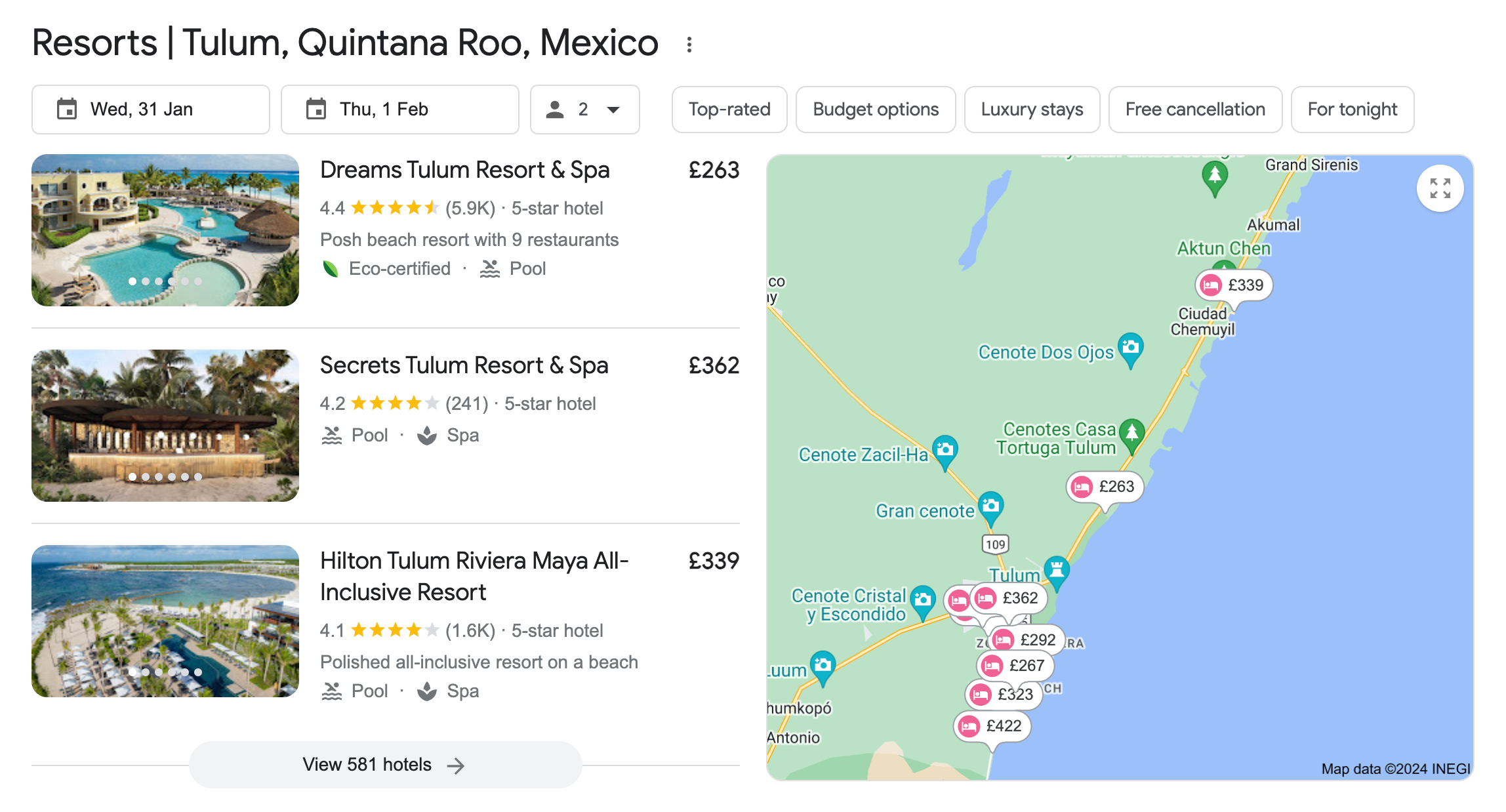
But the hotel pack is more than just a few listings. You can choose your selected dates, the number of guests, filter by things like free cancellation and more.
These listings open up into a detail page for the hotel, showcasing booking options:
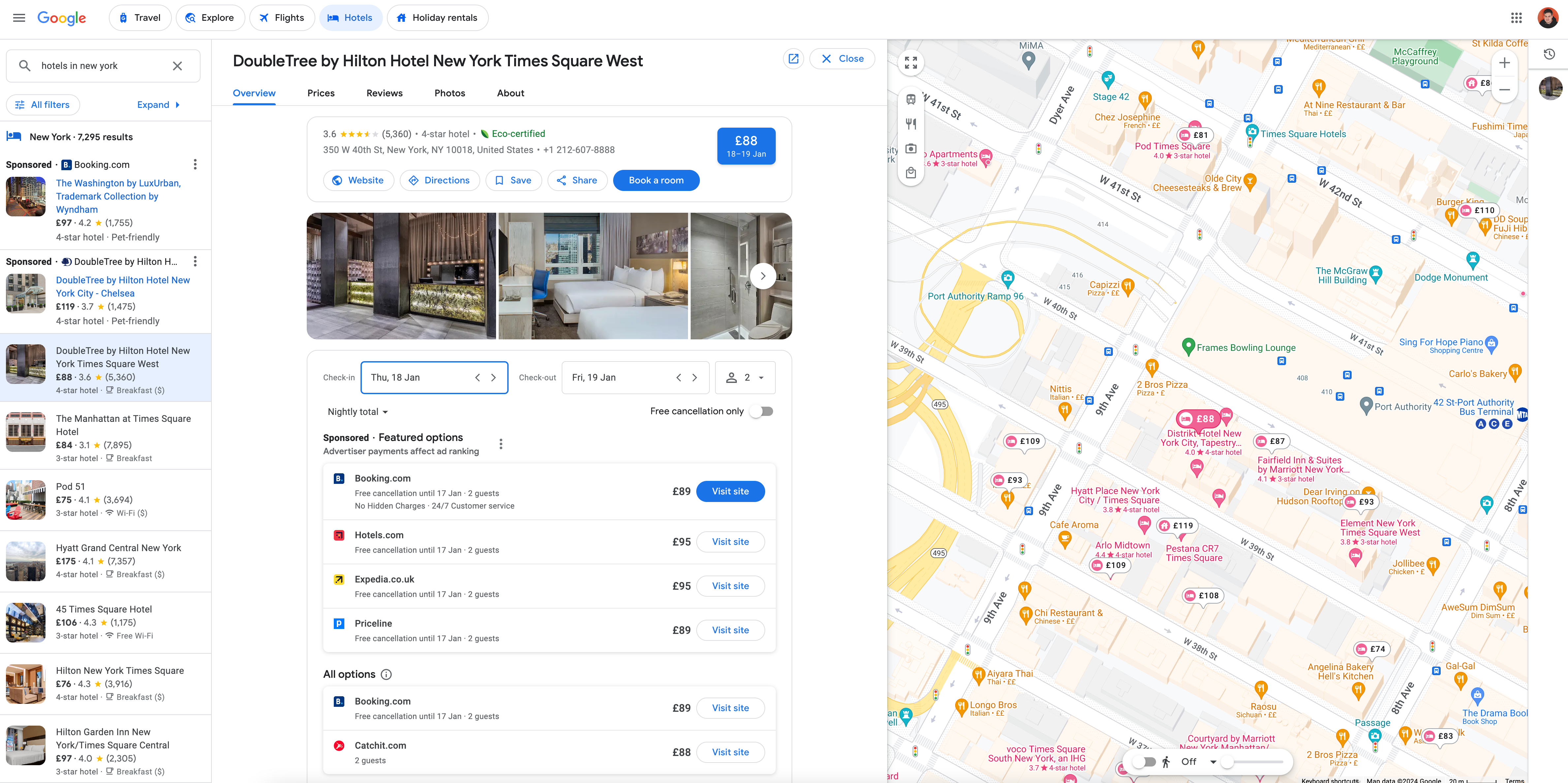
At the top of the results, you’ll find a block of sponsored listings. These are the results that are paying to be featured. Below are the organic results.
If you offer accommodation booking, you’ll want to work to get included in the hotel pack listings’ options.
I’m not specifically looking at ranking amongst the ‘free booking links’ on Google Hotel listings in this guide, but if you want to learn more, check out Google’s own guide to this.
Again, you need to be aware that certain Google features, in this case, the hotel pack, can push down organic results, therefore reducing the expected CTR of each position at the top of the SERPs.
Seasonality
Seasonality shouldn’t surprise any travel brand, but if you’re an agency person reading this and haven’t worked in travel SEO too much before, it’s something to be aware of.
Search volumes (and, therefore, the traffic you can expect) fluctuate across the year, in-line with when most people are researching destinations and booking.
To see what I mean, just look at the last 12 months’ trend in Semrush’s Keyword Overview tool for the query “Hotels in New York”:

See the dip from March to July in monthly search volume?
Take a different query, this time “all-inclusive resorts in Cancun,” and the trend looks very different:

You need to understand how seasonality affects search volumes and ensure you’re working this into your forecasting.
Most Bookings Are Carefully Considered Purchases
Most people don’t sink hundreds or thousands of pounds into booking a holiday without carefully considering their options. And this is something that’s actually a huge opportunity for travel brands to capitalise upon.
You see, travel bookings typically go on a journey from researching and choosing a destination to finding the right hotel and beyond. And this presents an opportunity to be visible at every stage.
From inspiring travellers with guides that recommend or suggest destinations at the start of their search journey to offering up hotel bookings and suggestions on things to do or places to eat, there are many different opportunities to leverage SEO to be visible when travellers are searching.
A considered purchase and lengthy conversion path are an opportunity to get in front of your target audience as a travel brand, but be aware that there can often be weeks, or even months, between the research starts and the booking happens. And then, this booking could be made months, or even a year or more, in advance.
There’s also the fact that people spend big on travel. But as with many big buys, there’s the want to spread this out over multiple payments. If relevant, travel brands should offer payment plans to spread the cost of the trip over a number of months.
“Travel” Covers a Lot of Different Types of Site
Travel covers all sorts of different businesses and website types, and we can break this down, at the top level, into:
- High street travel agents (e.g. Tui)
- OTAs (e.g. Booking.com)
- Hotels & resort groups (e.g. ClubMed)
- Hotels & resorts (e.g. Luxor Hotel)
- Attractions (e.g. Disneyland)
- Destination guides (e.g. Visit Orlando)
- Travel publishers (e.g. Lonely Planet)
- Travel blogs (e.g. Hand Luggage Only)
To a certain extent, there’s a lot of crossover between the tactics that work to drive growth for one type of travel site and another. But it’s important to get a feel for the diversity of different types of sites on the SERPs, what each of them has to offer searchers, and why some undoubtedly rank better than others.
Few sectors, bar perhaps finance, have more diversity in the type of sites that rank for a query.
What this also means is that some tactics aren’t going to be relevant for you. As we look at these, I’ll make it clear any recommended tactics that only apply to a small selection of travel site types.
The Helpful Content Update Hit (Some) Travel Sites HARD
Take a look at these three examples of travel sites that lost significant amounts of traffic during one or more Helpful Content or Core Algorithm updates over the last two years.
Site 1 – 99.6% traffic loss: From 222,085 monthly organic sessions in December 2022 to 971 in April 2024
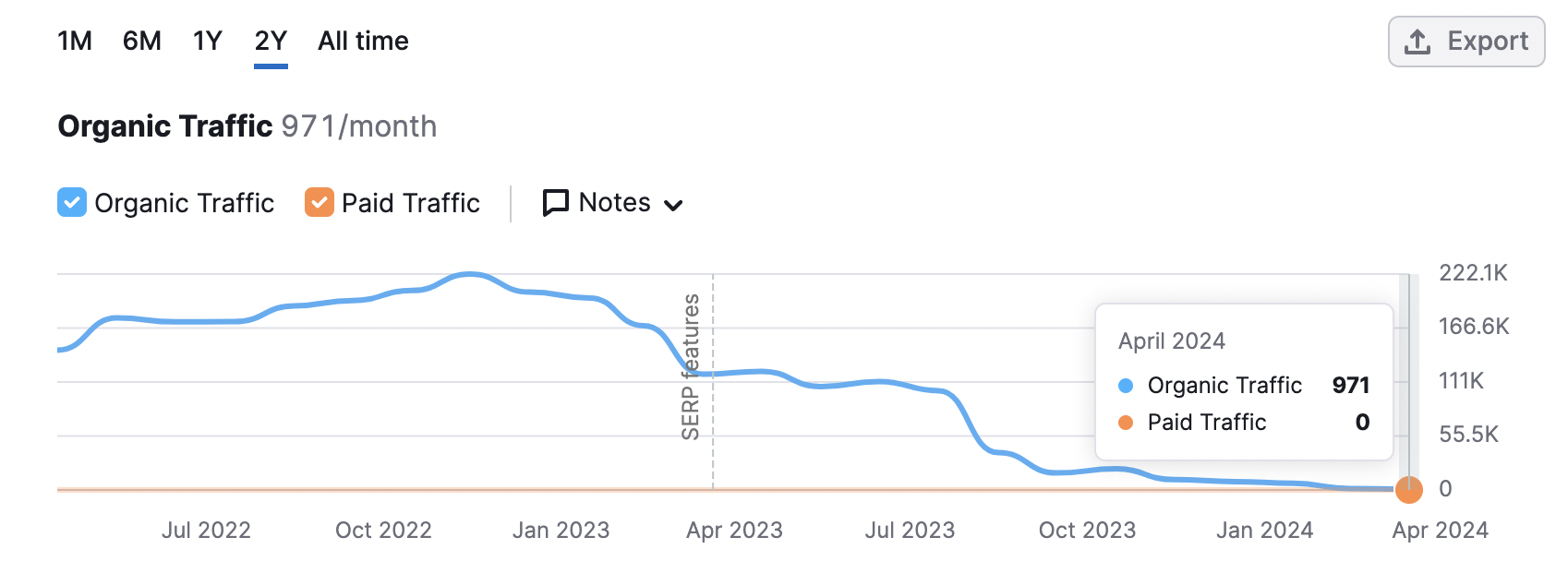
Site 2 – 99.8% traffic loss: From 372,604 monthly organic sessions in August 2022 to 576 in April 2024
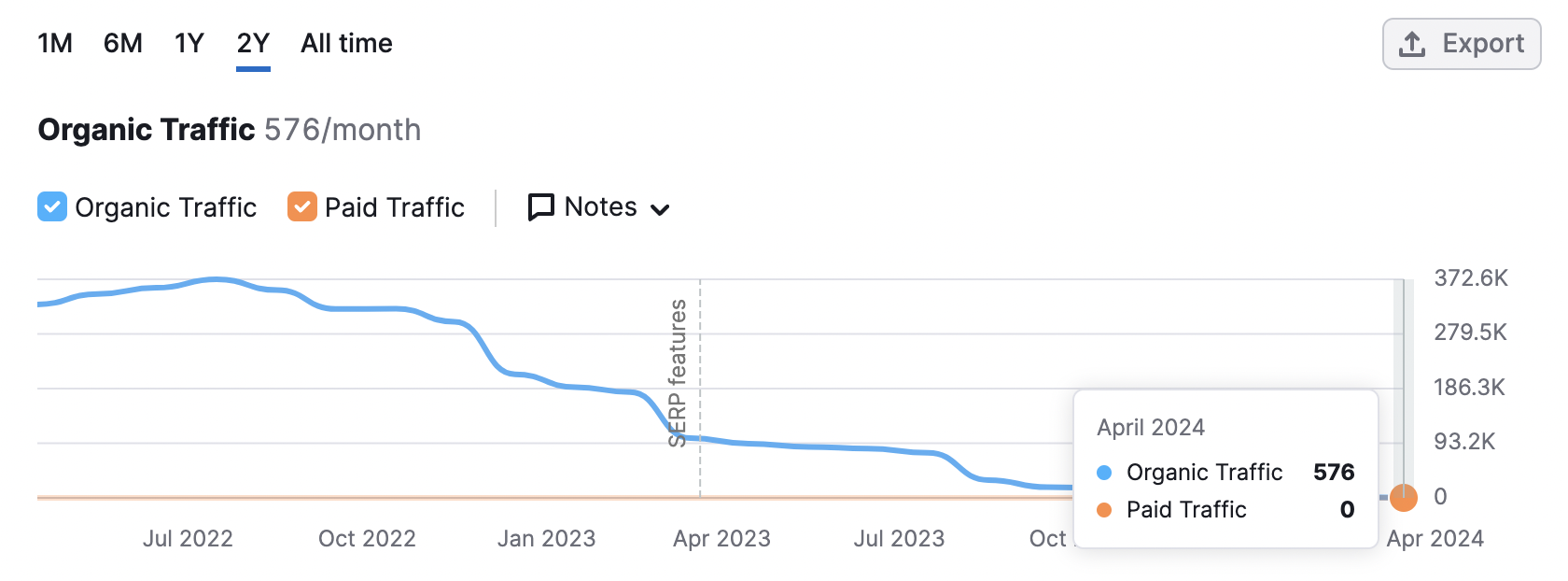
Site 3 – 99.9% traffic loss: From 4,362,051 monthly organic sessions in March 2023 to 2,433 in April 2024

Out of respect for the sites and their owners, I’m going to keep the URLs private, but hopefully, we can agree that these three travel sites may as well have been completely removed from Google.
And we can’t talk about how to drive SEO success as a travel website without sharing this.
Why?
These are just three of many examples that have seen similar declines during recent Google updates.
The best way to describe these three sites would be as travel blogs.
And Google has made it clear that travel is one of the most targeted sectors with the Helpful Content update. There’s no question about that.
There was a common trend amongst these three, and many more, travel sites that have been hit hard. They did absolutely nothing to demonstrate E-E-A-T, especially not experience.
These three sites all rely heavily on stock images and content that makes it pretty obvious their authors have never actually visited the places they’re writing about.
There’s more to this, though, of course. And, if you want to read more info on this, consider checking out our study into the impact of the HCU on travel publishers.
Does this mean that travel SEO is dead?
Of course not. In fact, it’s the complete opposite. Many travel sites are absolutely thriving on the SERPs following these updates.
But if you want to enjoy success, you need to make sure you can demonstrate E-E-A-T.
Everything You Need to Know About Ranking a Travel Site on the SERPs
It’s time to learn everything there is to know about ranking a travel site on the SERPs.
Whether you’re responsible for the SEO of an enterprise-level OTA, an airline, a hotel chain or a small tour operator, there are learnings here that you can take away and work into your own strategy.
Travel SEO is competitive, but get it right, and there’s an opportunity to win big…
Keyword Research & Content Strategy for Travel Brands
It all starts with a plan.
And planning in SEO usually means kickstarting a project with keyword research, competitor analysis and running technical SEO, content and link audits.
But the aim of this guide isn’t to teach you how to do SEO; it’s to look specifically at how you can drive success as a travel brand. This means I’m going to assume you’re comfortable with auditing your site and identifying and analysing your competitors.
Which brings us to keyword research.
After all, you need to identify how people are searching to be able to plan out your site’s key pages, supporting content, and it’s overall structure.
And especially in sectors like travel, I’m a big fan of going big with keyword research right from the start of a project and having a document that acts as the foundation for building out a long-term growth plan. I want a good idea of the entire keyword universe the site could target to determine the project’s scale and where to focus efforts.
But there’s a secret about travel SEO: you won’t often hear people talking about… keyword modifiers.
I’ll show you exactly what these are in a minute, but they’re your shortcut to finding hundreds, if not thousands, of keywords as a travel brand.
Before looking at keyword frameworks and how to find and use these, though, you need to get familiar with the four phases of a travel customer’s journey… you’ll want to tie your keyword research and your content strategy back to these, and understanding the steps a consumer goes through before making a booking is key to success.
Micro-Moments: The Phases of the Travel Customer Journey
You need to be visible across each micro-moment, the four phases of the travel customer journey:
- Dreaming Moments
- Planning Moment
- Booking Moments
- Experiencing Moments
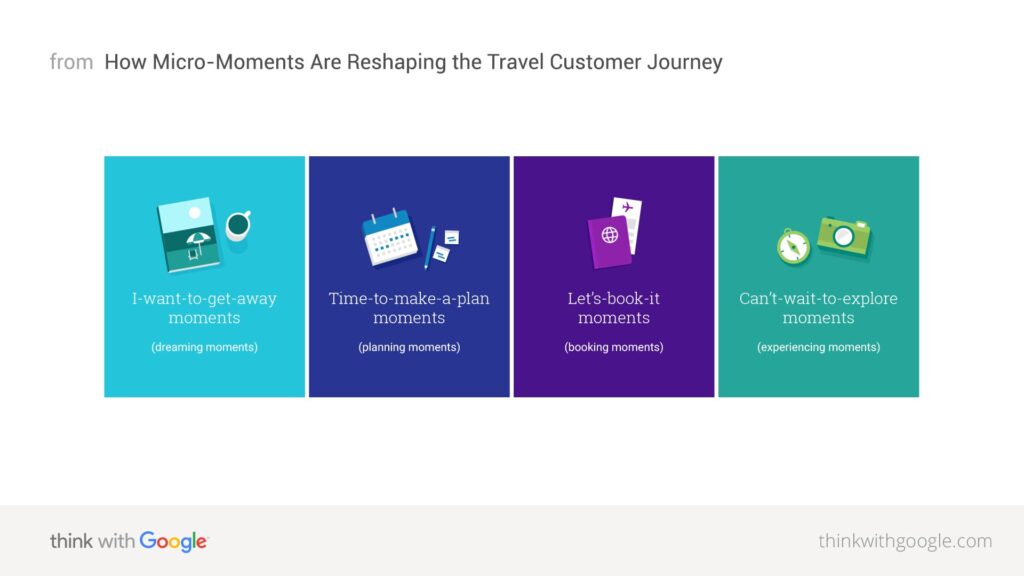
Think of the micro-moments as a framework to build your SEO strategy around, and consider the keywords you need to rank for and the content you need to create to make this happen at each.
Get in front of people when they’re in an “I want to get away” moment and again when they’re in a “time to make a plan” moment, and they’re more likely to return to you in their “let’s book it” moment. And if you want to make organic search a valuable channel, this is one of the fundamentals you need to get to grips with.
Travel bookings rarely happen on the first visit to a website. They’re considered purchases, and the journey can be somewhat lengthy and complex.
And this means you must be visible at every stage of the booking journey to win big and be the brand that lands the booking.
You need to invest in creating content that ranks for keywords across all four of the micro-moments, and look at success holistically. The more visible you are in those early moments, the greater your success will be in the later ones.
Group your keyword research by the four moments and see these as different steps in the journey, from booking a holiday to getting ready to go away. And the more confident you can get at visualising where different keywords fit into that journey, the stronger your strategy will perform.
Someone who ends up booking a holiday to Florida might make the following kinds of searches before and after making their booking:
- Where to go on holiday in April
- Where to visit in Florida
- Hotels in Orlando
- Hotels near Universal Studios
- Hotels on International Drive
- Best Family Hotels on International Drive
- Things to do in Florida with Kids
- Things to do in Orlando
- Universal Studios Orlando Tickets
- Best Restaurants on International Drive
These searches might happen over a period of days, weeks or even months, but it’s easy to see that this is all about going through a process where a consumer refines their searches, starting by looking for inspiration and getting more specific from there as they find ideas.
And once they’ve made their booking, the searches don’t stop. Often, they then move on to researching and booking attraction tickets, places to eat and more.
Search Volume vs Competition vs Intent
Keyword strategy plays a huge role in travel SEO, and an important part of this is building out a plan that carefully considers the monthly search volume, the competition and the intent of keywords.
Really, you need to determine whether or not your site stands a chance of ranking for any particular keyword and whether or not any traffic you drive from it would be likely convert into a booking.
Sometimes, ranking at the top of the travel SERPs for a keyword is going to be near on impossible unless you’re an established household name.
Let me give you a few examples…
For the keyword ‘hotels in London,’ there are 74,000 monthly searches, according to Semrush.

The top ten rankings on Google UK don’t include a single hotel’s site. Not one. We see a hotel group’s London hotels page ranking in position 11, but don’t see an individual hotel ranking until position 19.
In fact, we see an editorial roundup of the best hotels in London ranking before we see a single-location hotel.
If you’re a small single-location hotel, rankings for “hotels in London” would make very little commercial sense, even if it was possible, which would be very, very unlikely. There’s no specification on this search what type of hotel or what area of London the searcher is looking at, for example. It’s a broad search that it would make no sense to rank for unless you had a large number of hotels available, which meant the diversity of different wants could be served.
Think about it this way… why would Google rank an individual hotel when they can send searchers to pages that allow them to find and compare multiple?
They wouldn’t. Which is why the SERPs look like they do. Pretty much all OTAs.
If you’re an OTA or comparison platform, on the other hand, it makes perfect commercial sense to rank for this query, given the range of options you’ll be able to present to searchers. You’re also able to satisfy what Google wants to serve on the SERPs; choice, not a single location.
Chasing monthly search volume alone doesn’t make sense in travel SEO, largely due to how narrow the offering can be for a lot of travel providers.
Ask yourself how many of the searchers of a broad query you could serve or would be relevant to. In most cases, you’ll find this is very few and that it makes no sense to chase this keyword.
Look, in comparison, at a keyword that’s a lot more targeted to a single-location hotel, ‘Blackpool hotels with entertainment.’
This keyword still has a monthly search volume of 8,100, but the SERPs look very different to what we see for broader queries.
In fact, of the top ten rankings, 8 of these are single hotels rather than OTAs or comparison sites.
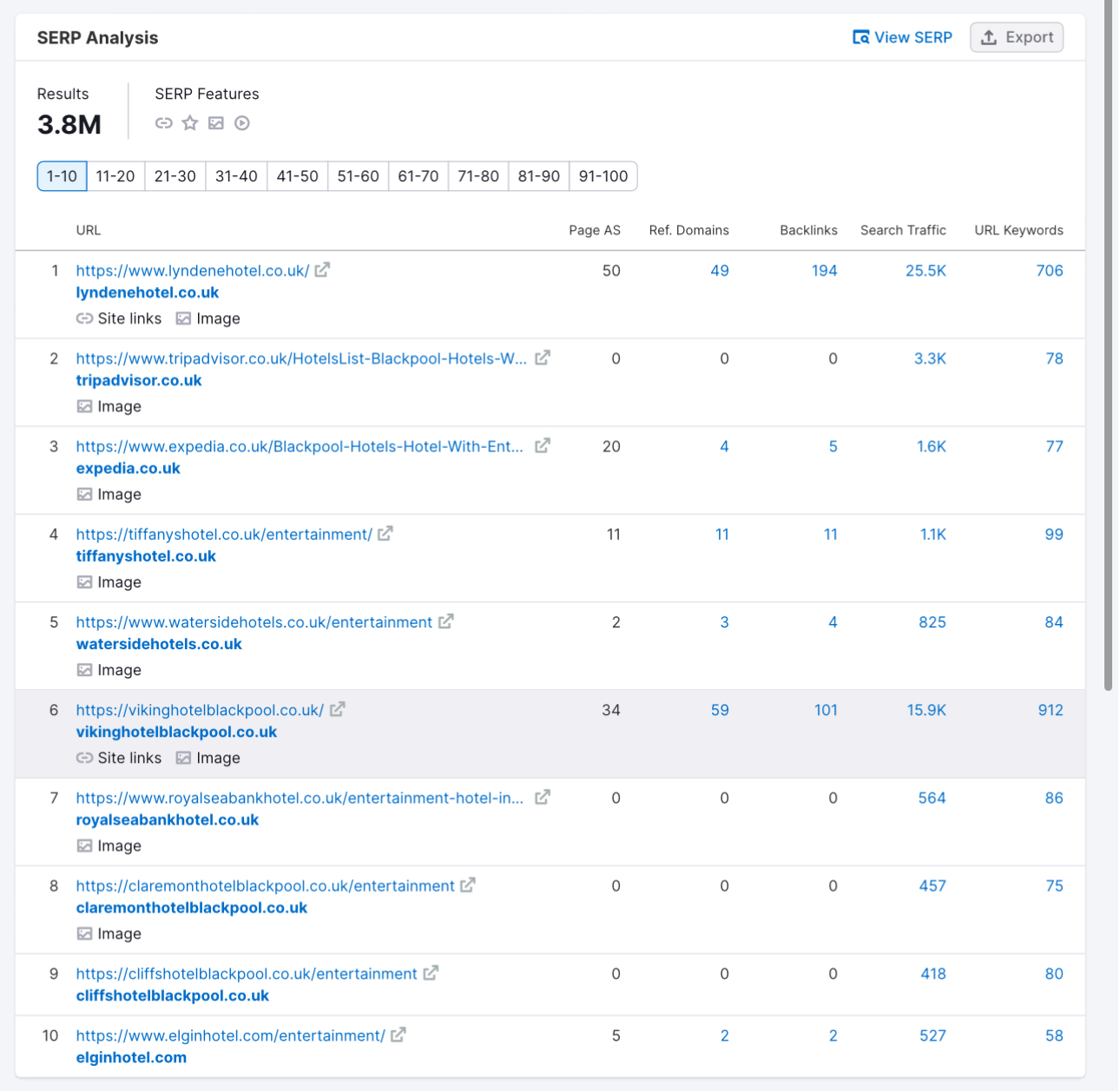
You need to understand where you can and can’t and should and shouldn’t compete with SEO.
Make decisions based on booking potential, either now or at a future time, and you’ll find it easier to ignore search volumes that can tempt you away from focusing on those areas that will actually see you succeed.
Understand the intent of the keywords you target: knowing what type of content ranks
Getting search intent right is so important to travel SEO success.
Not sure what intent means?
Quite simply, search intent’ refers to the reason or purpose behind a user’s search query. It represents what the user is looking to accomplish, or find, when they search for a specific keyword or phrase.
Understanding search intent helps you to ensure that the type of content you’re creating to target a specific keyword, for example whether you launch an informational guide or a grid of hotel options, matches what a user is looking for and, in turn, what Google wants to rank.
In fact, getting intent wrong is pretty much a guaranteed way not to rank.
There are four main types of search intent:
- Informational Intent: The user is looking for information or answers to specific questions. Examples include queries like “when is the best time to visit Rome?”.
- Navigational Intent: The user is trying to find a specific website or page. For instance, a user searching for “TUI”.
- Transactional Intent: The user wants to make a purchase or complete some form of transaction. Examples include searches like “hotels in Paris”.
- Commercial Investigation: The user is considering a purchase and is looking for information to help make a decision. This might include searches like “best hotels in Paris”.
And you can understand the intent behind a query simply by looking at what currently ranks on Google. You’ll usually see trends. But be aware that it is possible to have mixed-intent SERPs, where a mix of different intents show on the first page of results.
Understanding and optimising for search intent is crucial for effective travel SEO, on the grounds that it ensures that the content aligns with what users are actually seeking, in turn improving relevance and increasing the likelihood of higher rankings.
And this leads us onto the topic of keyword cannibalization.
The Challenge of Avoiding Keyword Cannibalization
It’s really easy to cause keyword cannibalization issues in the travel space.
This is when you’re (usually accidentally) competing against yourself on the SERPs. When you’ve got more than one page targeting the same keyword with the same intent and sending conflicting signals to the search engines as to which should be ranked.
For a number of reasons that I won’t explore here (it’s a whole post in itself), this can result in neither page ranking as highly as it otherwise would.
Want an example of keyword cannibalization in travel? Here are two keywords…
| Family Hotels in Greece | Family Resorts in Greece |
To target these terms, should you create two pages or one?
On the face of it, you could assume that you’d need to create two pages here; one targeting ‘resorts’ and the other targeting ‘hotels.’
But it’s not quite that simple.
You see, in many ways, family resorts and family hotels are one and the same. Could you expect someone searching ‘family hotels in Greece’ to want to be shown resorts? And not just the hotel group properties in the cities?
I’d argue that most people searching for ‘family hotels in Greece’ actually want to explore the resorts on offer; those with kids clubs, beach access and other facilities for the kids.
But you can’t just guess at this.
Why?
Because there’s no blanket rule here. It depends on the query being searched for.
Another example? Here are two more keywords…
| Hotels in Cancun | Resorts in Cancun |
What are you thinking?
This one’s a little harder to figure out. The overlap isn’t as clear; the searcher could be looking for an all-inclusive resort for two weeks, or they could be looking for a hotel in the city for a night or two.
There’s a lot to suggest that the results should be different here.
Rather than guessing (please, don’t do that), be guided by the data.
That way, if you need to create two pages, go ahead and do this. But if Google understands that the intent of two or more queries is the same, just create one.
You can use Keyword Insights‘ ‘keyword clustering’ tool to get this data. Here’s what the tool does, in its own words:
“When creating new content, knowing when a particular piece should be broken out into more specific sub-topics can be challenging. For example, if we had the keywords “architect fees” and “how much do architects cost?” would you quickly know whether you need 2 different pages to target these or if they could be targeted on the same blog?
“Keyword Insights makes this quick and painless. We use live search results pages and group keywords based on what’s ranking. So you’ll know, in seconds, when a page should be broken out into sub-topics to stand the best chance of ranking.”
Let’s run the four keywords I looked at above through this tool to answer the question on whether these examples should actually be split up into two pages or targeted as one.
Here’s what we see:

The data shows that, to target these four keywords, three pages need to be created:
- Family Hotels & Resorts in Greece
- Hotels in Cancun
- Resorts in Cancun
Perhaps more than in most other industries, keyword cannibalization can be a real challenge for travel brands. But rely on the data, and you’ll be in a position to prevent this from happening in the first place.
A Proven Keyword Research Process for Travel Websites
When it comes to keyword research, travel is by far one of the easiest sectors to do this for.
Why?
Because pretty much every keyword (not all, but most) is based around a destination. This means that any keyword you find can be used multiple times, just by switching in a different destination.
Want to learn more about how this works?
Common Keyword Modifiers for Travel Brands
Keyword modifiers are your shortcut to rapid keyword research. And whilst these can be used in quite a few industries, travel is by far the one where they’re the most effective.
Keyword modifiers work like this:
{keyword} + {modifier}
And the most common ones you’ll probably want to use are these…
| Keyword Modifier | Example |
|---|---|
| Holidays to {country} | Holidays in Greece |
| Holidays to {region} | Holidays in Florida |
| Holidays to {city} | Holidays in Miami |
| Hotels in {country} | Hotels in the USA |
| Hotels in {region} | Hotels in Florida |
| Hotels in {city} | Hotels in Miami |
| Hotels in {suburb} | Hotels in Miami Beach |
| Villas in {country} | Villas in the USA |
| Villas in {region} | Villas in Florida |
| Villas in {city} | Villas in Orlando |
| Villas in {suburb} | Villas in Kissimmee |
| All Inclusive Holidays to {country} | All Inclusive Holidays to Greece |
| All Inclusive Holidays to {region} | All Inclusive Holidays to Corfu |
| All Inclusive Holidays to {city} | All Inclusive Holidays to Sidari |
| Last Minute Holidays to {country} | Last Minute Holidays to Greece |
| Last Minute Holidays to {region} | Last Minute Holidays to Corfu |
| Last Minute Holidays to {city} | Last Minute Holidays to Sidari |
| Things to do in {country} | Things to do in Greece |
| Things to do in {region} | Things to do in Corfu |
| Things to do in {city} | Things to do in Sidari |
| Family Holidays to {country} | Family Holidays to Greece |
| Family Holidays to {region} | Family Holidays to Corfu |
| Family Holidays to {city} | Family Holidays to Sidari |
| Family Hotels in {country} | Family Hotels in Greece |
| Family Hotels in {region} | Family Hotels in Corfu |
| Family Hotels in {city} | Family Hotels in Sidari |
| Luxury Hotels in {country} | Luxury Hotels in Greece |
| Luxury Hotels in {region} | Luxury Hotels in Corfu |
| Luxury Hotels in {city} | Luxury Hotels in Sidari |
| Resorts in {country} | Resorts in Greece |
| Resorts in {region} | Resorts in Corfu |
| Resorts in {city} | Resorts in Sidari |
| Family Resorts in {country} | Family Resorts in Greece |
| Family Resorts in {region} | Family Resorts in Corfu |
| Family Resorts in {city} | Family Resorts in Sidari |
| All Inclusive Resorts in {country} | All Inclusive Resorts in Greece |
| All Inclusive Resorts in {region} | All Inclusive Resorts in Corfu |
| All Inclusive Resorts in {city} | All Inclusive Resorts in Sidari |
| Adult Only Resorts in {country} | Adult Only Resorts in Greece |
| Adult Only Resorts in {region} | Adult Only Resorts in Corfu |
| Adult Only Resorts in {city} | Adult Only Resorts in Sidari |
| Best Hotels in {country} | Best Hotels in Greece |
| Best Hotels in {region} | Best Hotels in Corfu |
| Best Hotels in {city} | Best Hotels in Sidari |
| Flights to {destination} | Flights to Las Vegas |
| Flights from {destination} to {destination} | Flights from Manchester to Las Vegas |
| Car Hire in {destination} | Car Hire in Orlando |
| Things to do in {destination} | Things to do in Orlando |
| Free Things to do in {destination} | Free Things to do in Orlando |
| Things to do With Kids in {destination} | Things to do With Kids in Orlando |
These are by no means the only keyword modifiers that can be used by travel brands. I could easily quadruple this list and more.
But they’re a great starting point and hopefully, inspiration to help you spot these shortcuts when conducting keyword research and planning your content strategy.
And it’s really easy to see how this concept works.
Find a keyword and switch out the destinations for others where you have an offering. Very quickly, you can built a starting list for your keyword research.
Of course, I’m talking about how to build out a seed keyword research list here. I’m not meaning you should go ahead and use destination variables within content… that’s a whole different topic.
But when it comes to doing keyword research, this is a powerful way to speed up the process, especially if you operate across a large number of destinations.
Once you’ve got your list, run it through your favourite keyword research tool (I’m a fan of Semrush for this, but Ahrefs and others work just as well) to collect the data which, in turn, can help you to prioritise your focus areas.
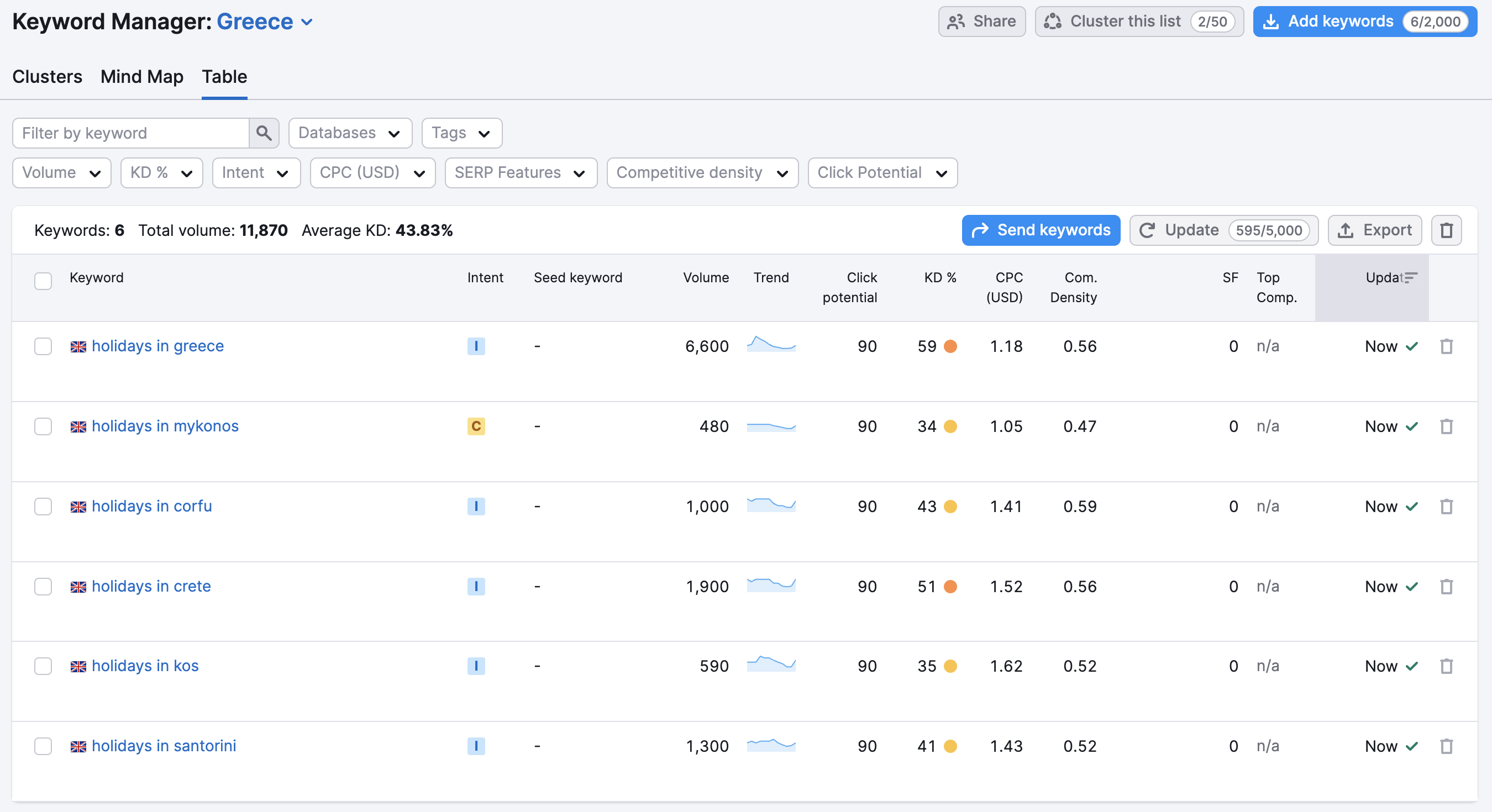
I’m also a big fan of Semrush’s clustering tool at this stage to help find other keyword (and modifier) ideas.
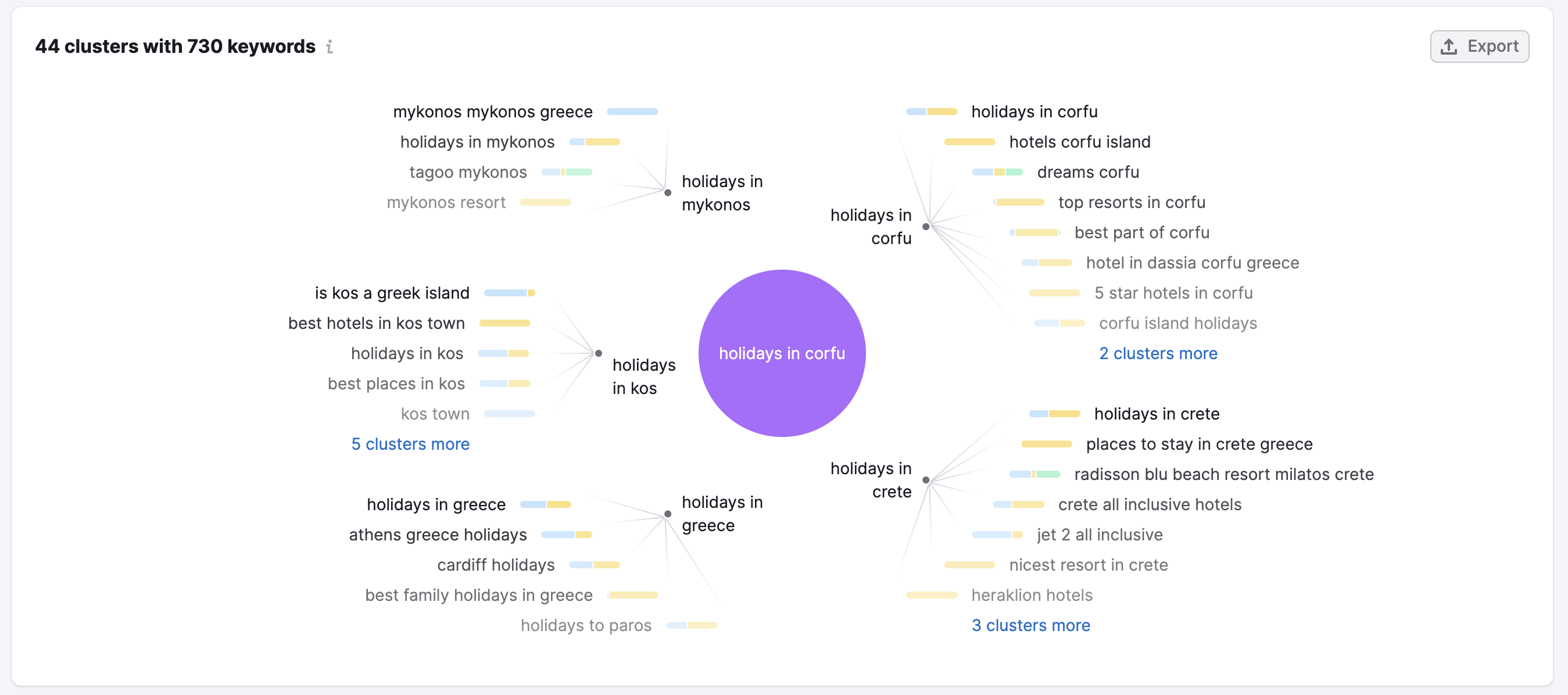
Of course, you should go beyond this to find keywords that don’t fit into these frameworks, but it’s a great starting point and one that can speed up the process significantly!
Building Out a Travel Content Strategy: Essential Page & Content Types
Building on keyword research, let’s now take a look at the different page and content types that travel brands will typically need to create as part of their strategy.
Of course, they won’t all be relevant to every travel site, but this covers the bulk of ones there are. Make sure you skip past any examples that aren’t relevant to your specific offerings.
Destination Pages
A huge number of travel-related searches are made to find destination pages, and these apply to most travel websites.
These pages are targeted to a continent, region, country, city or even suburb and usually act as hub pages for that destination. They’re the pages that act as the main page for each destination, where you’ll link to more specific locations and offerings, and provide information and inspiration.
Examples of destination page recommendations and their target keywords include:
| Primary Keyword / Page Heading | Page URL |
|---|---|
| Florida Holidays | /usa/florida/ |
| Orlando Holidays | /usa/florida/orlando/ |
| Miami Holidays | /usa/florida/miami/ |
| Florida Keys Holidays | /usa/florida/keys/ |
| International Drive Holidays | /usa/florida/orlando/international-drive/ |
| Fort Lauderdale Holidays | /usa/florida/fort-lauderdale |
| Clearwater Holidays | /usa/florida/clearwater/ |
| Daytona Beach Holidays | /usa/florida/daytona-beach/ |
| Tampa Holidays | /usa/florida/tampa/ |
These are the top-level pages for some of the main destinations in Florida, as an example.
You’ll notice that the URL structure in these examples reflects the relationship of destinations to one another, too. All of these are nested within the /usa/ folder (country), and you’ll see /usa/florida/orlando/international-drive/ nested even deeper, given that International Drive is a popular tourist hotspot in Orlando.
As a general rule, you want to nest destinations like this:
/{country}/{region}/{city}/{suburb}
If you only operate in one country or region, exclude these as it makes sense to do so.
Want to see a few examples?
Check out these destination pages from TUI and Thomas Cook to give you a good idea of how to structure this type of content and what to include:


The purpose of destination pages is to really sell the place itself and to inspire. These are usually browsed during “dreaming” and “planning” moments and should be seen as a top-level overview of a location.
Typically, you’ll want to include the following on this type of page:
- An overview of the destination
- Links to the key locations within this destination where you have offerings
- A round-up of top ‘offerings’ in the destination
- Key facts about the destination
- Links to sub-pages of the destination that aren’t for other locations
Of course, make these specific to your business, but that’s a good starting point to aim for.
Accommodation Type Pages
Once a tourist has decided on one or more destinations that they’re considering travelling to, one of the next searches they make is typically relating to accommodation.
And this means searches for ‘hotels in…,’ ‘villas in…’ or other accommodation types.
These pages are typically accommodation listings, showcasing all of the options available in that destination, alongside filtering to allow users to refine based on what they’re looking for.
Examples of accommodation-type page recommendations and their target keywords includes:
| Primary Keyword / Page Heading | Page URL |
|---|---|
| Hotels in Florida | /usa/florida/hotels/ |
| Hotels in Orlando | /usa/florida/orlando/hotels/ |
| Hotels in Miami | /usa/florida/miami/hotels/ |
| Villas in Orlando | /usa/florida/orlando/villas/ |
| Villas in Kissimmee | /usa/florida/kissimmee/villas/ |
You’ll notice in these examples that they’re nested within the destination subdirectory. And this is always preferential, helping to keep content organised and in a URL structure that expands out from the destinations themselves.
Check out these destination pages from TUI and Virgin Holidays to give you a good idea of how to structure this type of page and what to include:


Accommodation type pages help tourists find options for where to stay once they’ve decided on a destination and accommodation type. They are usually browsed during “planning” moments and as the user approaches “booking” moments. They should be seen as a category page that includes all available accommodation of that type.
Holiday Type Pages
Not everyone’s search for a holiday starts with a destination in mind.
Sometimes, they’re looking for inspiration on where to go, based on their criteria of a certain type of holiday.
This could be a family holiday, a beach holiday or another type.
These searches come in the ‘dreaming’ and ‘planning’ moments, and are an opportunity for travel brands to really influence the destinations that travellers consider for their next holiday.
At this stage in their journey, they’re likely still open to different destinations, and want to be inspired and pointed towards suitable options.
Really, it’s a chance to recommend.
Examples of holiday type page recommendations and their target keywords includes:
| Primary Keyword / Page Heading | Page URL |
|---|---|
| Family Holidays | /family-holidays/ |
| Adult-Only Holidays | /adult-only-holidays/ |
| Beach Holidays | /beach-holidays/ |
| Couples Holidays | /couples-holidays/ |
| Ski Holidays | /ski-holidays/ |
The reality is, is that these are going to be limited to what a company has to offer. Some sites, therefore, will naturally have more of an opportunity with these page types than others.
But it’s all about thinking about the different ways people search and what they expect from each of these. Then making sure you’re matching this intent.
Take a look at these two examples of holiday type pages from Kuoni and TUI for ‘adult-only holidays’ and ‘family holidays’ for inspiration:


When planning out and building this type of page, consider including things like:
- Links to recommended destinations for that travel type
- Information on what makes your offering tailored to this type of travel
- Links to informational / guide content that expands on this type of travel to help users make decisions on where to go
It’s all about selling the benefits of this type of holiday and giving recommendations, inspiring and helping share top tips on where to go for this.
Destination + Holiday Type Pages
Some holidaymakers will pretty much combine destination and holiday type searches once they’ve made some decisions on where they’re wanting to go on holiday to.
They’re looking for a specific holiday type (a family holiday, for example) in a certain location.
And here are a few examples of this type of content:
| Primary Keyword / Page Heading | Page URL |
|---|---|
| Family Holidays to Florida | /usa/florida/family-holidays/ |
| Family Holidays to Orlando | /usa/florida/orlando/family-holidays/ |
| Couples Holidays to Florida | /usa/florida/couples-holidays/ |
Really, they’re an extension of ‘holiday type’ pages, but with the specifics relating to a destination, not in a general sense.
As examples, take a look at these two pages from TUI and Thomas Cook:


Whilst on first glance, these two pages look a little different to oneanother, the basic concept of them is the same, they’re just laid out a little differently. Key things to include for this type of page are:
- A summary on why the destination is a great choice for that type of holiday
- Accommodation or package listings for that type of holiday in that destination
Flight Pages
These ones are easy to understand, but have to be included given flights are such a big part of the travel industry.
As a heads up though, the flights space is pretty damn competitive, with Google themselves taking up so much search real estate.
There’s also competition from the airlines themselves, and their partner airlines, as well as giants like Skyscanner and Kayak.
These searches typically come when someone is looking to book a flight on its own, not as a package.
But it’s important not just to focus on the ‘to’ and the ‘from’ destinations in isolation.
Just look at some examples of recommended flights pages for the right travel brand:
| Primary Keyword / Page Heading | Page URL |
|---|---|
| Flights to Florida | /flights/destinations/florida/ |
| Flights from Manchester to Orlando | /flights/routes/manchester-to-orlando/ |
| Flights from London to Orlando | /flights/routes/london-to-orlando/ |
It’s not just people searching for ‘flights to {destination}’. They’re also defining their starting airport, as well.
But just what is expected on pages like these? Here are two examples from Kayak and Virgin Atlantic:


There’s a lot here. Lots of data. Lots of different flight options. And lots of value.
In fact, that’s probably what’s most important here if you want to compete against these giants … figure out how you can add more value than the other results.
Car Hire Pages
Like with flight pages, car hire pages shouldn’t need much of an introduction.
If you offer car hire through your site, you’ll need these and need to understand how to set them up for success. If you don’t they’re not something you’ll need to think about.
Just like flights, the car hire space is competitive. But it’s also a huge opportunity to understand just how people search.
Look at these keyword examples:
| Primary Keyword / Page Heading | Page URL |
|---|---|
| Car Hire in Florida | /car-hire/usa/florida/ |
| Car Hire in Orlando | /car-hire/usa/florida/orlando/ |
| Car Hire at MCO (Orlando) Airport | /car-hire/usa/florida/orlando/mco/ |
| Car Hire on International Drive, Orlando | /car-hire/usa/florida/orlando/international-drive/ |
Even in these four examples, we’ve got searches for:
- Car hire in the state
- Car hire in the city
- Car hire at the airport
- Car hire in a specific location in the city
And here are a few examples of how top-ranking sites are setting up their car hire pages:


Of course, these pages need to be based around the ability to search for car hire in the location for specific dates, that’s a given. But beyond this, there’s a need to look at how value can be added. Some of the examples here include:
- Top deals and their pricing
- Tips to find the best deals
- FAQs
- Other key information about the airport or location
“Best {keyword} in” Pages
There’s a real opportunity for travel brands to appear in front of potential tourists at every stage of their booking journey, as I’ve already talked about with the Micro Moments.
And this involves having a solid informational, full-funnel content strategy that lets you target people doing their research beyond just looking for resort, hotel or holiday listings.
One of the essential content types here is “Best…” pages.
Have a look at these keyword examples:
| Primary Keyword / Page Heading | Page URL |
|---|---|
| Best Hotels in Florida | /guides/best-hotels-in-florida/ |
| Best Hotels in Orlando | /guides/best-hotels-in-orlando/ |
| Best Family Hotels in Orlando | /guides/best-family-hotels-in-orlando/ |
| Best Hotels on International Drive, Orlando | /guides/best-hotels-on-international-drive/ |
| Best Water Parks in Florida | /guides/best-water-parks-in-florida/ |
When someone’s searching for “Best…,” they’re looking for recommendations. For editorial write ups, in most cases.
And by understanding there’s a different intent between “Hotels in Florida” and “Best Hotels in Florida,” you’re able to leverage the opportunity to create both an informational guide and a hotel listings page, if that’s what you offer.
Here are a few examples:


The reality is that these are pretty standard informational guides. Just be sure to take the time to look at what already ranks on the SERPs and consider how you can add value beyond what’s already there.
Informational & Inspirational Content
The “Best…” pages I gave the example of above are one type of informational content, but the reality is that there’s a lot more. Content types that don’t fit any one particular framework.
Here’s a few examples:
| Primary Keyword / Page Heading | Page URL |
|---|---|
| Destinations that are hot in December | /guides/hot-destinations-in-december/ |
| What to pack for a cruise | /guides/what-to-pack-for-a-cruise/ |
| Ski resorts with the most snow | /guides/ski-resorts-with-the-most-snow/ |
| When is the best time to go to the Maldives? | /guides/best-time-to-go-to-the-maldives/ |
| Weather in December in Orlando | /guides/weather-in-december-in-orlando/ |
Going back to the concept of full-funnel content marketing, we’ve got tourists at different stages of their booking journey looking for information and for inspiration.
Just like these:


You need to make sure you’re leveraging informational content as part of your travel SEO strategy, ensuring you’re the brand who is getting in front of potential customers at every stage of their search for their next holiday or trip.
Branded Search Pages – Reviews & Discounts
Whilst it’s easy to focus pretty much solely on non-branded search terms with SEO, that shouldn’t be the case.
If you’re not ranking for your own brands’ discounts and reviews terms, you’re essentially letting someone else collect an affiliate commission or have the limelight for when someone looks for a review.
And that’s why every travel brand, at least those where transactions take place, should be publishing their own pages that rank for:
- {brand} discount codes
- {brand} reviews
Just like these examples from TUI:


At the end of the day, you’ve got an opportunity to control what potential customers see when they look for a discount or seek to learn more about your brand or service.
On your discount codes page, be sure to share live deals. If you offer no discounts and always have the best prices direct, then say that.
On your reviews page, embed the best reviews from platforms like Trustpilot, as well as sharing any awards or accreditations. This is a real opportunity to show the best bits that other people have said about you.
Planning & Producing Rank-Ready Travel Content
Content is an essential part of any successful travel SEO strategy, and those brands that win on the travel SERPs invest heavily into producing content right across the funnel, from those dreaming moments to helping make those experiencing moments a little bit more enjoyable (and easier).
But one thing that’s for certain is that the content you produce has to truly be standout to stand a chance of ranking in 2024.
Don’t worry, though. There are plenty of opportunities to create content that ranks for competitive queries, and for this to actually happen.
You just need to understand the difference between ‘good’ content and ‘great’ content, and take these learnings into your content production efforts.
When it comes to producing travel content that ranks, here are my top tips and things to make sure you’re doing, and those things to avoid:
- Start by taking a look at what ranks at the top of Google right now and get a feel for what is performing well. It’s not about copying this like-for-like, but about understanding the depth of content you need to create.
Let’s say, for example, you’re waiting to rank a hotel listings page for ‘Hotels in Orlando.’ Have a look at the SERPs to understand what sort of depth you need to add alongside the hotel listings. Does the page need destination information? Links to more granular searches (hotel types or other smaller areas within the location)?
Looking at the SERPs tells you a lot about what you actually need to create.
But don’t just stop here.
Take the time to speak with experts within your business. That can mean travel advisors. Destination specialists. Customer service team members.
Talk to people outside of the marketing team to identify what your users want to know, and use this as a way to add value.
The goal should always be to create a better page than what already ranks top. And whilst ‘better’ is subjective, working with experts within the business can help you to really identify what users want.
- Don’t be afraid (and even, actively do it) to link out to external authority sources.
Long gone is the myth that linking out to other sites will ‘leak PageRank’ or somehow harm your own rankings. It won’t.
If you’re talking about a place, citing some statistics or similar, then link out to this source. Both your users and search engines will thank you for it. - Remember that word count doesn’t equal value. Whilst it can be tempting to write as much as you can for a page, think about what’s actually needed. Sometimes, more is less.
What’s more important is the value that’s within your content, not necessarily its length.
You can have a page that’s 500 words and packed full of way more value than a 5,000-word page, for example. - Always try and use your own photos and images, where possible.
I get it. Avoiding ‘stock images’ in travel can be hard, but it’s a great way to differentiate yourself from others if you can use your own photos and images within your content. - Write naturally and avoid stuffing keywords into your pages. Again, that tactic is long-gone.
When you write in a natural way, having put together a framework for the information you need to get across on a page, you shouldn’t need to try to work keywords into your content. It should happen naturally when writing about the topic.
Above everything else, focus on how you can give value to your users in every piece of content you create and think about how you can create ‘the best piece of content on the web’ for the topic.
On-Page SEO
On-page SEO must be a key tactic in any travel website’s SEO strategy, and involves optimising the page and its content.
Here are the key aspects of on-page SEO for travel sites you need to know:
Title Tag Optimisation
Title tags are one of the most crucial on-page SEO elements, and optimising these should be the absolute basics. If you’ve not optimised your page titles properly, you’re not going to rank anywhere near as well as you could.
Title tags (usually, but they can be rewritten by Google) appear on the SERPs as the clickable headline for a given result and should be concise, compelling, and include relevant keywords.

Make sure you include a page’s target keyword in the title tag, and make sure it’s clickable. In other words, make it really clear what the page is about, but consider how you can make these stand out against the other results.
The example above from TUI?
Here’s what it does well:
- Includes the page’s main target keyword (All Inclusive Holidays to Greece)
- Includes additional information in the form of the years booking – 2024/2025
Make sure you’re including the page’s main target keyword as close to the start of the title tag as possible.
It’s also useful to know that Google uses click data for rankings, making it even more important that your title tags are not only keyword-optimised but also set up to make searchers want to click on your result.
Think about what would make people click on your result over others. Things such as:
- Pricing information (e.g. … from £XX.XX)
- Availability information (e.g. X Resorts Available)
Look at the SERPs and have a think about what would make yours stand out.
Meta Description Optimisation
While Google no longer uses meta descriptions as a ranking factor, they’re still displayed on the SERPs, right below the title tag.

And although they don’t directly impact rankings, well-written meta descriptions can improve click-through rates.
For travel websites, it’s beneficial to highlight unique selling points and standout information from the page you’re optimising, such as special offers, the variety of options you have available, or user reviews, while incorporating target keywords.
The TUI example above covers the main bases of a great meta description:
- Includes the primary target keyword (this gets bolded)
- Includes more information about the offering; in this case showcasing everything that’s included in TUI all-inclusive bookings
- A call to action – ‘Book online with TUI today!’
Again, remember that click data influences rankings. Think about how you can leverage your meta description as a way to encourage people to click your result over someone else’s.
H1 Tag Optimisation
The H1 tag is typically the main heading of a page and should clearly describe a page’s content.

It’s important to ensure each page has a single H1 tag that includes its primary target keywords and provides a clear, engaging introduction to the content.
In the example above, we see a great example of this, a well-optimised H1 tag that reads “All Inclusive Holidays to Greece.” The H1 tells you exactly what the page is; there’s nothing out of the ordinary. In this case, it’s a collection of all-inclusive holidays to Greece; something that’s also the page’s main target keyword.
Usually, you won’t need to overthink this, just be descriptive and align H1 tags with your page’s target keywords.
In short, each page should have only one H1 tag and provide a clear signal to search engines about the main topic.
Additionally, you’ll want to ensure that each H1 tag is unique across your website. Avoid generic headings like “Travel Guide” on multiple pages; instead, focus on unique H1 tags that reflect the specific content of each page.
H2 – H6 Tag Optimisation
Optimising H2 to H6 tags is often overlooked but is an important part of structuring content effectively and improving the SEO performance of your site.
H tags should follow a hierarchical structure and, ideally, be nested.
- H1
- H2
- H3
- H4
- H5
- H6
- H5
- H4
- H3
- H2
The likelihood is that most sites won’t get down as far as using H5 and H6 tags. And even using H4 tags can be rare. But knowing how these should be used means you can use them when appropriate.

Let’s look at using these tags a bit deeper:
H2 Tags: Main Subheadings
H2 tags serve as the main subheadings under the H1 tag, breaking down your content into major sections. For travel websites, use H2 tags to introduce significant topics within a page.
H3 Tags: Supporting Details
H3 tags further divide the sections introduced by H2 tags into more detailed subsections. This level of detail helps users find specific information quickly and keeps your content well-organised.
H4 – H6 Tags: Additional Breakdown
H4 – H6 tags are used to break down H3, H4 and H5 sections even further, providing more granular detail. Don’t worry if your content doesn’t need this level of granularity; a lot doesn’t.
Maintain consistency in how you use H tags to ensure a logical flow of the content. Each tag should follow a natural progression, making your page’s content easy to read and navigate.
Incorporate relevant keywords and variations naturally into your H2 to H6 tags where these apply to the sections they relate to. However, avoid keyword stuffing—ensure that the headings make sense and provide value to the reader.
URL Optimisation
A clean and descriptive URL structure helps both search engines and users understand the content of your pages.
Ensure your URLs are descriptive and relevant to the page’s content. A URL like www.travelwebsite.com/best-beaches-in-thailand clearly indicates what the page is about, making it easier for users and search engines to understand. Avoid using vague or generic URLs such as www.travelwebsite.com/page12345, which provide no context about the page content.
The URL structure which the TUI example I’ve been using has is: https://www.tui.co.uk/destinations/europe/greece/holidays-greece/all-inclusive-holidays
Here’s a quick look at the best practices to consider when optimising URLs:
- Use hyphens to separate words in your URLs instead of underscores. or example, use www.travelwebsite.com/family-friendly-resorts instead of www.travelwebsite.com/family_friendly_resorts.
- Maintain a consistent URL structure throughout your site to ensure a logical and user-friendly experience, as I’ll discuss below when talking about topic clustering. A consistent URL structure helps users and search engines navigate and understand your site more efficiently. For example, if you use a category-based URL structure, stick to it across all pages, such as www.travelwebsite.com/destinations/europe/spain.
- Avoid using special characters in your URLs, such as ?, &, or %. These characters can create confusion and complications for both users and search engines. Instead, keep URLs clean and straightforward, with only letters, numbers, and hyphens.
- Always use lowercase letters in your URLs. Mixed-case URLs can lead to duplicate content issues, as search engines could treat www.travelwebsite.com/Best-Beaches and www.travelwebsite.com/best-beaches as different pages if things like canonicalisation are not set up correctly. Consistently using lowercase letters helps avoid this problem.
- Keep your URLs short and simple. Long, complex URLs might get truncated in search results. Aim for brevity while maintaining descriptiveness, such as www.travelwebsite.com/bali-travel-guide rather than www.travelwebsite.com/the-ultimate-bali-travel-guide-and-itinerary-for-2024.
A well-considered URL structure not only helps users to understand what section of your site they’re clicking into, but it also helps search engines to better understand the topical context of pages.
Topic Clustering & Site Architecture
I’ve already touched on this a little bit in the content type examples, but one thing you need to properly plan out when doing SEO for a travel website is your site’s architecture (how your site’s URLs and subdirectories are structured and linked together) and your topic clusters.
Not familiar with what topic clusters are?
According to HubSpot, who pioneered the concept, “The topic cluster model, at its core, is a way of organizing a site’s content pages using a cleaner and more deliberate site architecture.”
Check out this video to learn more about how to set these up:
For a travel website, this typically means setting up your site in a way that groups content (pages) together in a way that makes sense.
This usually means grouping content by:
- Destination (e.g. country)
- Travel type (e.g. skiing or cruises)
- Product category (e.g. flights or car hire)
But why are topic clusters so important as part of your SEO strategy?
Topic clusters offer significant benefits for SEO by improving (and making it easier to understand) the site structure, enhancing content relevance, and increasing a site’s ability to rank for entire topics.
This approach involves creating a central “pillar” page covering a broad topic (e.g. Florida) and linking it to multiple related “cluster” pages (e.g. Orlando, Miami or Key West).
This internal linking helps search engines understand the depth and breadth of your content, increasing the likelihood of ranking for a variety of related keywords.
Furthermore, topic clusters can enhance topical authority, positioning your site as a comprehensive resource within your niche.
At the end of the day, think about it this way… would you sooner trust a site that has just a single page of content on a particular topic? Or which covers a topic in great depth?
Hopefully, you agree it’s the latter.
Want to see an example of this in practice? Here’s one from a recent strategy deck we produced for a travel client, suggesting the most effective way to cluster content for their luxury vacation rentals provider:
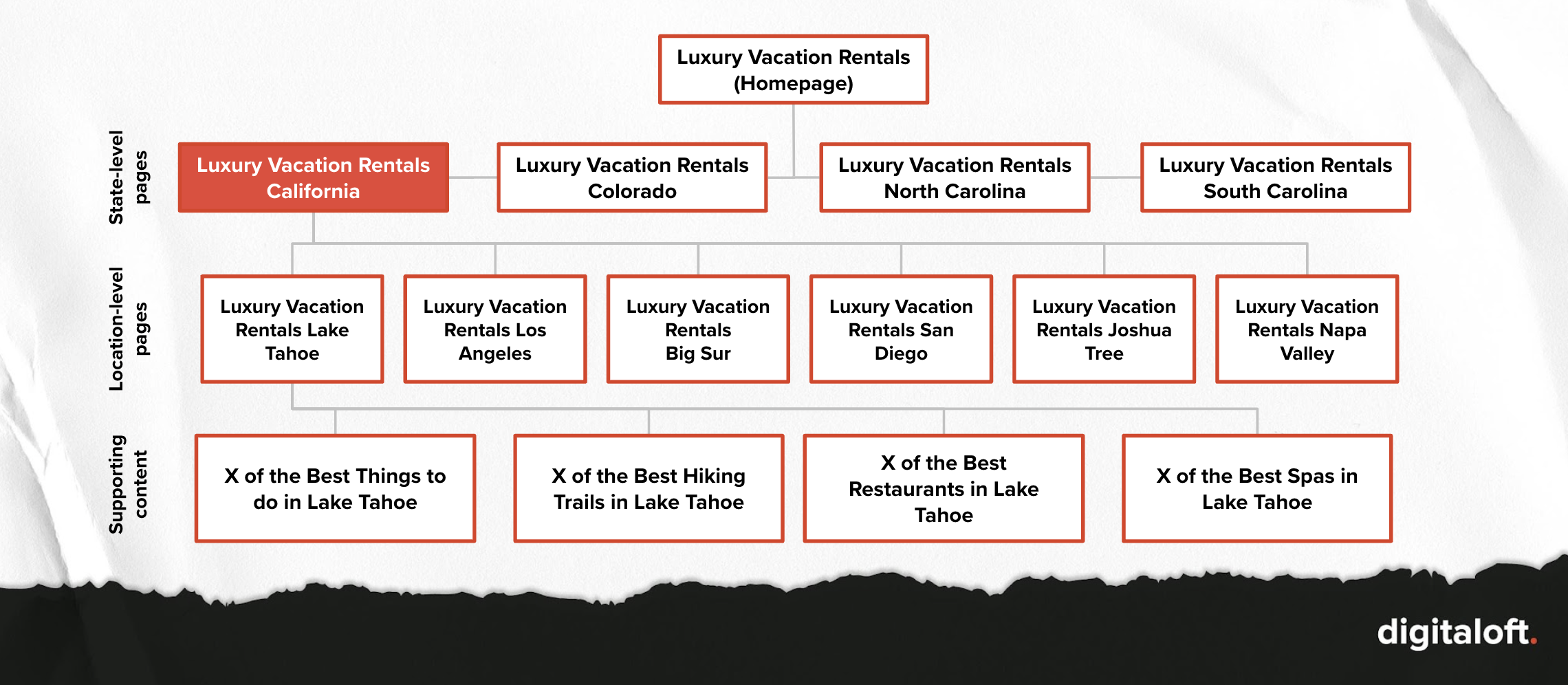
This example maps out how we’d structure a topic cluster for ‘Luxury Vacation Rentals California’ as follows:
- Luxury Vacation Rentals in California
- Luxury Vacation Rentals in Lake Tahoe
- X of the best things to do in Lake Tahoe
- X of the best hiking trails in Lake Tahoe
- X of the best restaurants in Lake Tahoe
- X of the best spas in Lake Tahoe
- Luxury Vacation Rentals in Lake Tahoe
Notice how this follows a hierarchy?
- State rental listings
- Location rental listings
- Informational content
- Location rental listings
You don’t always need to keep all cluster pages in a topic cluster in the same subdirectory, the same concept can be achieved using internal linking.
Take the time to plan out your topic clusters, especially how you’ll use internal linking to demonstrate the contextual connection between pages, and you’re setting your site up for success.
It’s all about taking a broader concept (pillar page) and ‘supporting’ this with content that goes deeper into the specifics of a topic. In the case of travel, it’s going down this hierarchy from location to supporting this with informational content, all of which demonstrates your site’s knowledge and expertise across each location and travel type.
Internal Linking
There are so many opportunities for travel sites to leverage internal linking, yet it’s something that often gets overlooked.
Why? I’m not sure, especially given that it’s a key tactic in helping to rank pages on the SERPs.
Internal linking refers to the tactic of creating links that connect one page of a website to another page on the same site.
These are important for several reasons:
- They help search engines discover new content on your site.
- They distribute link authority throughout your site.
- They pass contextual signals that help search engines understand what the linked-to pages are about.
- They assist users in navigating your site and finding relevant information.
Take a look at this guide from TravelSupermarket:
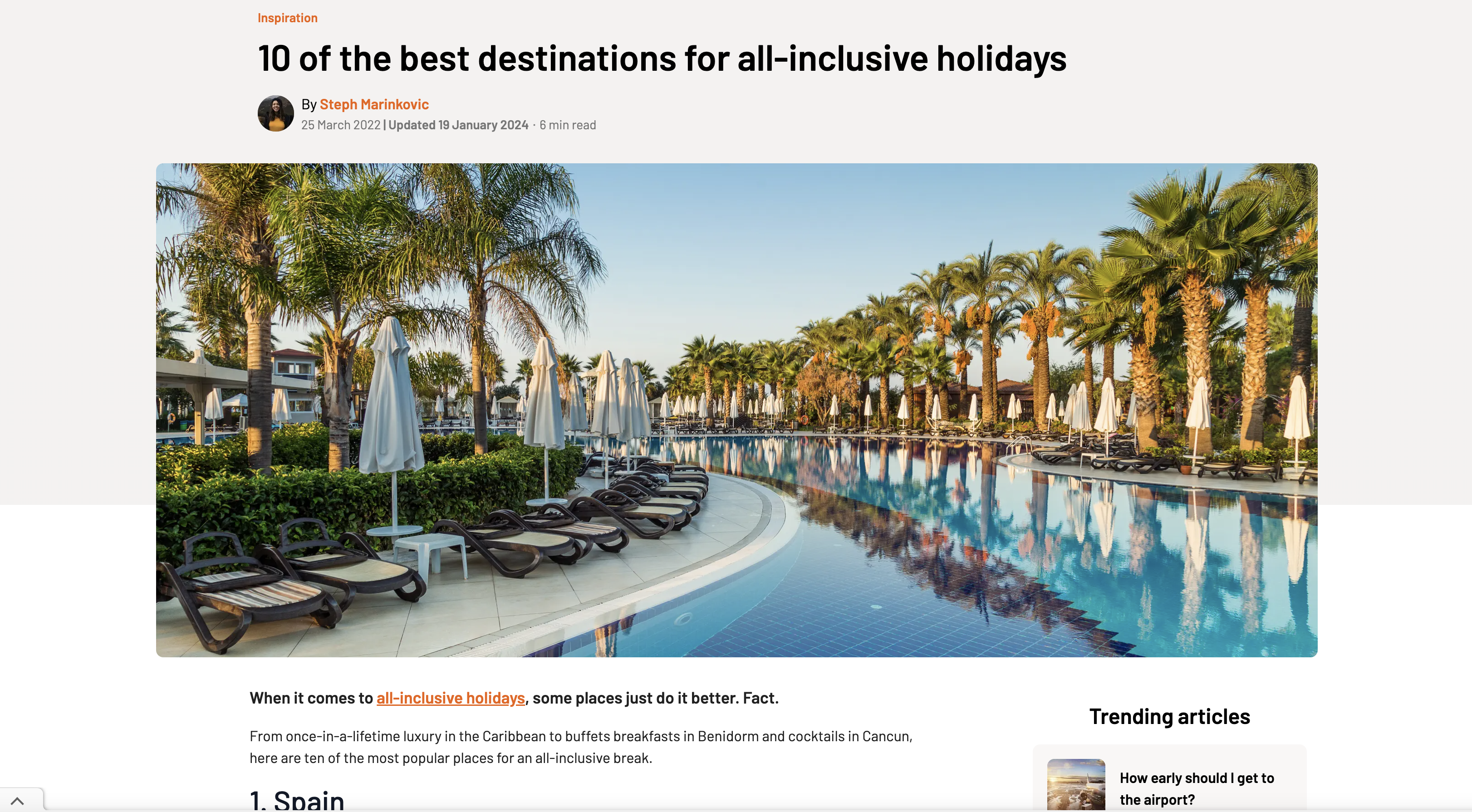
That ‘all-inclusive holidays’ link?
That’s an internal link. It links to the site’s ‘all-inclusive holidays’ page (https://www.travelsupermarket.com/en-gb/holidays/all-inclusive/).
When it comes to building internal links, here are a few main things to consider:
- Use Descriptive Anchor Text: The clickable text of your internal link (anchor text) should be descriptive and relevant to the target page. This helps search engines understand the context of the linked page and improves the chances of ranking for relevant keywords.
- Link to Relevant Content: Ensure that your internal links add value by pointing to content that is relevant to the reader. Avoid linking just for the sake of SEO; the goal is to enhance the user experience and provide additional useful information. When you focus on linking to relevant content, you’re also building all-important contextual signals.
Publishing new content? Go back into older content and add internal links to the new one; it’ll help it get indexed faster and rank higher, too.
Digital PR
There’s no getting away from the fact that links remain one of the three pillars of SEO success.
But links aren’t just links.
And Google’s recent documentation leak has confirmed even more so that digital PR is the primary tactic that should be being used to increase a site’s authority and, in turn, earn links as a result of this.
Add to this the fact that travel and digital PR perfectly go hand in hand.
But first, a quick introduction to digital PR as a tactic.
Digital PR is, in many ways, the intersect between traditional PR and link building. It’s all about creating stories and pitching to the press, all executed in a way that earns links back to the site.
I guess we could call it modern-day link building, to some extent.
But the reality is that digital PR is about SO MUCH MORE than just building links. Digital PR can help your travel brand to:
- Earn editorial links from relevant and authoritative publications
- Increase brand awareness
- Drive referral traffic
- Build and demonstrate E-E-A-T
- Drive social engagement
And more…
And it’s important to know that digital PR isn’t just one tactic. It’s an umbrella of different tactics such as:
- Data-driven studies and reports
- Proactive and reactive expert insights
- Product PR
- Brand PR
But what does this look like in practice?
Our study into the USA’s hidden gems for Bounce landed coverage like this on Travel Noire (DR73):
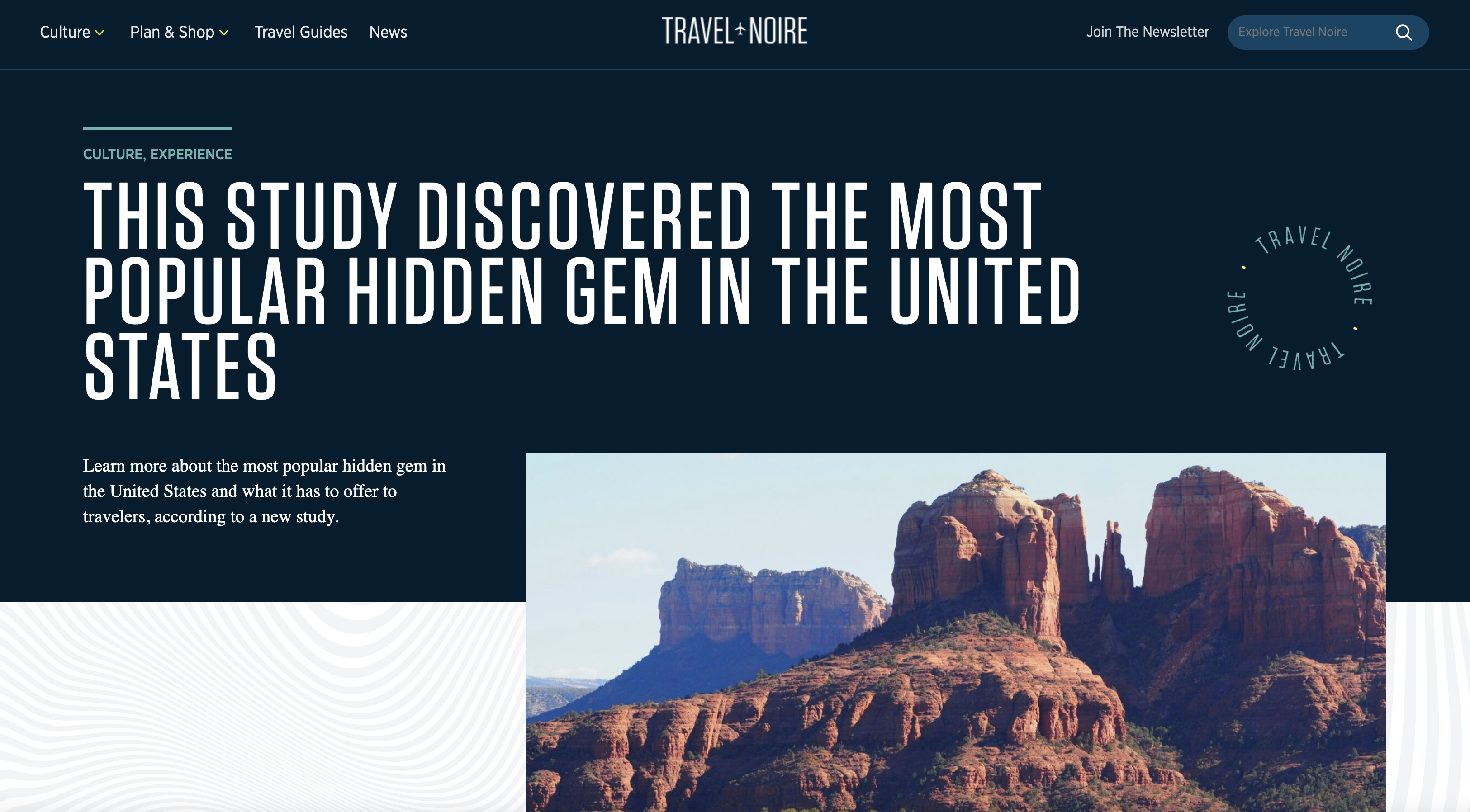
And this proactive expert insights piece sawt the same brand’s CEO share his top tips with Best Life (DR79):

Other Link Building Tactics
Whilst, for many travel brands, digital PR is going to be the most effective way to earn links to support SEO growth, that doesn’t mean other tactics should be ignored.
And it’s a sector where there are plenty of opportunities to earning links that are not only relevant but which also have the potential to drive significant levels of referral traffic, especially for accommodation providers, attractions and similar types of business.
Specifically, I mean opportunities that see travel businesses recommended or included in listings. And whilst some of these definitely fall into PR, a lot don’t.
Wanna see some examples?
Let’s assume you’re working on the SEO for a travel company that specialises in offering vacation rentals in California. And you want to earn relevant links to increase the rankings for your ‘vacation rentals in Big Sur’ page.
If I run a search on Google for ‘where to stay in Big Sur’ (as an example), I see pages like:
| URL | Page Type |
|---|---|
| https://www.timeout.com/california/hotels/best-hotels-in-big-sur | Press feature |
| https://www.cntraveler.com/story/best-big-sur-hotels | Press feature |
| https://www.visitcalifornia.com/experience/where-stay-big-sur/ | Accommodation recommendations |
| https://www.tripadvisor.co.uk/Hotels-g240329-Big_Sur_California-Hotels.html | Hotel listings |
| https://www.bigsurcalifornia.org/lodging.html | Accommodation recommendations |
| https://www.bontraveler.com/big-sur-hotels-california/ | Blog article |
| https://www.thislifeoftravel.com/usa-west-coast/big-sur-where-to-stay | Blog article |
| https://www.bigsurcali.com/lodging | Accommodation recommendations |
| https://www.californiabeaches.com/big-sur-unique-accommodations/ | Blog article |
| https://www.seemonterey.com/regions/big-sur/hotels/ | Accommodation recommendations |
This isn’t the top 10 rankings. I’ve picked out a selection of different page types.
The press features? You’ll need to leverage digital PR tactics to land on those, and TripAdvisor is only relevant if you’re a hotel yourself.
But the others? There are opportunities here.
Let’s look at the Visit California page:

Lots of recommendations on where to stay, with links to their sites.
Reaching out to sites like these to justify why your listing should be included makes perfect sense. Drop them a line. Often, you’ll find it’s easier to get added to resources like this than you think if you make a good case. What do you offer that others don’t?
The same goes for BigSurCali.com:
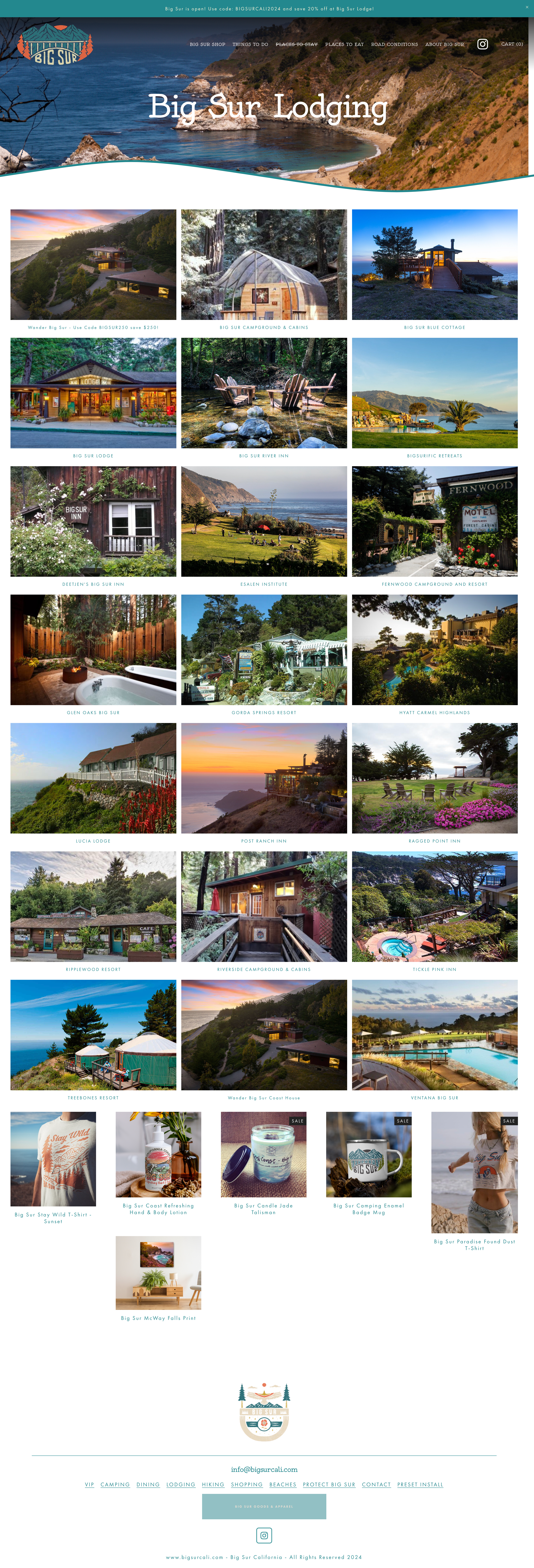
The blogs?
Reach out, like with these, and justify why you’d be a great addition. Just be warned, many bloggers will ask for payment to link out. And paying for links goes against Google’s guidelines on link spam.
Also take a look whether any relevant business directories exist.
A quick search for ‘Big Sur business listings’ returned some possible sites you could get listed on here
- https://www.bigsurcalifornia.org/lodging.html
- https://whatsupmonterey.com/business-directory
- https://businessdirectory.montereyherald.com/
- https://www.carmel.com/hotels
Don’t discount grabbing listings on relevant business directories that could send you traffic as well.
And above anything else, don’t just rely on digital PR as a way to earn links. Yes, it’s powerful and important, but other opportunities do exist, too.
Schema
Schema markup is a powerful tool that can significantly enhance the visibility and user experience of travel websites in search engine results. By providing structured data that search engines can easily understand, schema markup allows travel websites to showcase rich, detailed information directly in the search results.
Here are some key benefits of implementing schema markup for travel websites:
Rich Snippets and Enhanced Visibility: Schema markup enables travel websites to display rich snippets in search results, which can include details such as prices, ratings and reviews. These eye-catching snippets make listings more informative and attractive, increasing the chances of users clicking through to the website.
Here’s an example:

See the star ratings and subsequent information below the result? They’re powered by Schema.
Better Local Search Visibility: For travel businesses targeting local audiences, schema markup can improve visibility in local search results and maps. By incorporating location data and business information, travel websites can increase their chances of appearing in relevant local searches.
To effectively implement schema markup for travel websites, it’s crucial to identify the appropriate schema types and properties. Some commonly used schema types in the travel industry include:
- LodgingBusiness: For hotels, resorts, and other accommodation listings, this schema type allows you to showcase details like room types, amenities, and check-in/check-out policies.
- LodgingBusiness > Hotel
- LodgingBusiness > BedAndBreakfast
- LodgingBusiness > Campground
- LodgingBusiness > Hostel
- LodgingBusiness > Motel
- LodgingBusiness > Resort
- LodgingBusiness > VacationRental
- TouristAttraction: This schema type is ideal for highlighting attractions, landmarks, and points of interest, including details such as opening hours, ratings, and accessibility information.
- TouristDestination: This schema type is ideal for showcasing destinations, cities, or regions that are popular travel locations. It allows you to provide structured data about the destination, including details such as attractions, activities, climate information, and recommended visit durations.
- TouristTrip: For travel packages and itineraries, this schema type enables you to provide structured data about destinations, activities, and duration.
- TravelAgency: This schema type is useful for travel agencies, tour operators, and online travel booking platforms. It allows you to provide structured data about the agency, including details such as areas served, types of travel services offered, and customer reviews.
- Event: For showcasing upcoming events, festivals, or conferences related to travel, the Event schema type can display crucial details like dates, locations, and ticket information.
It’s important to note that while schema markup is not a direct ranking factor, it can significantly improve your website’s visibility and user engagement, which can indirectly contribute to better search engine rankings over time.
By leveraging schema markup effectively, travel websites can enhance their organic presence, attract more qualified traffic, and ultimately drive more bookings and conversions, whilst helping them to stand out on the SERPs.
Google’s structured data guidelines are a great place to start to learn more about implementing this.
E-E-A-T
E-E-A-T matters a lot more for travel websites than you might initially think.
This acronym stands for Experience, Expertise, Authoritativeness and Trustworthiness, and whilst it’s not a direct ranking factor, it’s a big deal.
You see, in recent years, Google has doubled down on rewarding content that has been produced by people who have experienced the thing they’re writing about or have expertise in the subject, as well as content that’s published by trustworthy sites considered to be an authority.
Yes, this can be pretty vague if you’re new to the concept, but this essentially means:
Experience: Ensure that content is authored by individuals with firsthand travel experience, even if those individuals are travel advisors. Include personal stories and recommendations, reviews, and real-life insights enhance the content’s credibility and relatability.
Expertise: Highlight the knowledge and skills of writers where it makes sense to do so. It’s important to understand that travel content, by its nature, doesn’t require formal expertise in the same way as finance or medical niches would, though. Experience means far more than expertise for travel websites.
Authoritativeness: You need to earn and develop a strong reputation by earning mentions (and links) from reputable travel sites and industry experts. You can do this by consistently providing high-quality, reliable information and recommendations and leveraging digital PR to distribute this.
Trustworthiness: You need to maintain transparency, accuracy, and honesty in content, as well as earning and displaying positive reviews, having secure booking processes and comprehensive contact information that fosters trust with potential travellers. Trust is the most important E-E-A-T factor.
In terms of top tips for demonstrating E-E-A-T for a travel website:
- Make it clear who the author of informational content and recommendations within destination pages is, having standalone author pages that are linked to.
- Use destination experts as the authors for your content and to give recommendations. If you’re an OTA, have a USA travel expert author content about the USA, for example.
- Incorporate expert insights within your content. For example, include a section of ‘tips from our travel advisors’ on destination or travel type pages to add unique value.
- Use unique images or videos within your content. Maybe the biggest giveaway that you’ve not experienced a place is by using stock images. Build your own image bank and work to take your own photos.
- Make sure it’s easy for travellers who are considering booking, or have already booked, to contact you. Make contact details really clear.
- Invest in making your About Us page amazing. Make it really easy for potential travellers to learn about who you are, what you offer and why they should trust you. This is a great place to clearly display any memberships and accreditations you hold.
- Make it really easy to find reviews from past guests of your service and offering(s).
- Ensure you’re using trusted and secure payment gateways if processing transactions.
E-E-A-T is only going to become more important, and when it comes to travel SEO, it’s all about demonstrating experience and insights into a destination or holiday type above everything else.
Technical SEO
Technical SEO is all about ensuring that Google and other search engines can crawl, index and understand your site and its content.
And in many ways, it’s a baseline requirement for ranking on the SERPs.
At the end of the day, if your pages can’t be crawled or indexed, no amount of links or great content will help you rank. And that’s why I often talk about technical SEO as the foundation of SEO success.
But, despite what some people might have you believe, it’s also rarely a growth driver. And by this, I mean that if you have significant technical SEO issues, you’ll be underperforming where you should be, and fixing these should be a priority. But making improvements to things that aren’t actually holding you back likely won’t be growth drivers in the same way that content and links are.
Below, I’ll examine some of the key technical SEO requirements for travel websites. Some of these may not be an issue for your site, but you should at least be aware of them.
PageSpeed & Core Web Vitals
Improving your site’s PageSpeed and Core Web Vitals isn’t just important from a technical SEO point of view. It’s just as crucial for providing a great user experience to site visitors.
But how do you go about doing this?
Firstly, go and test your site using Google’s PageSpeed Insights tool.
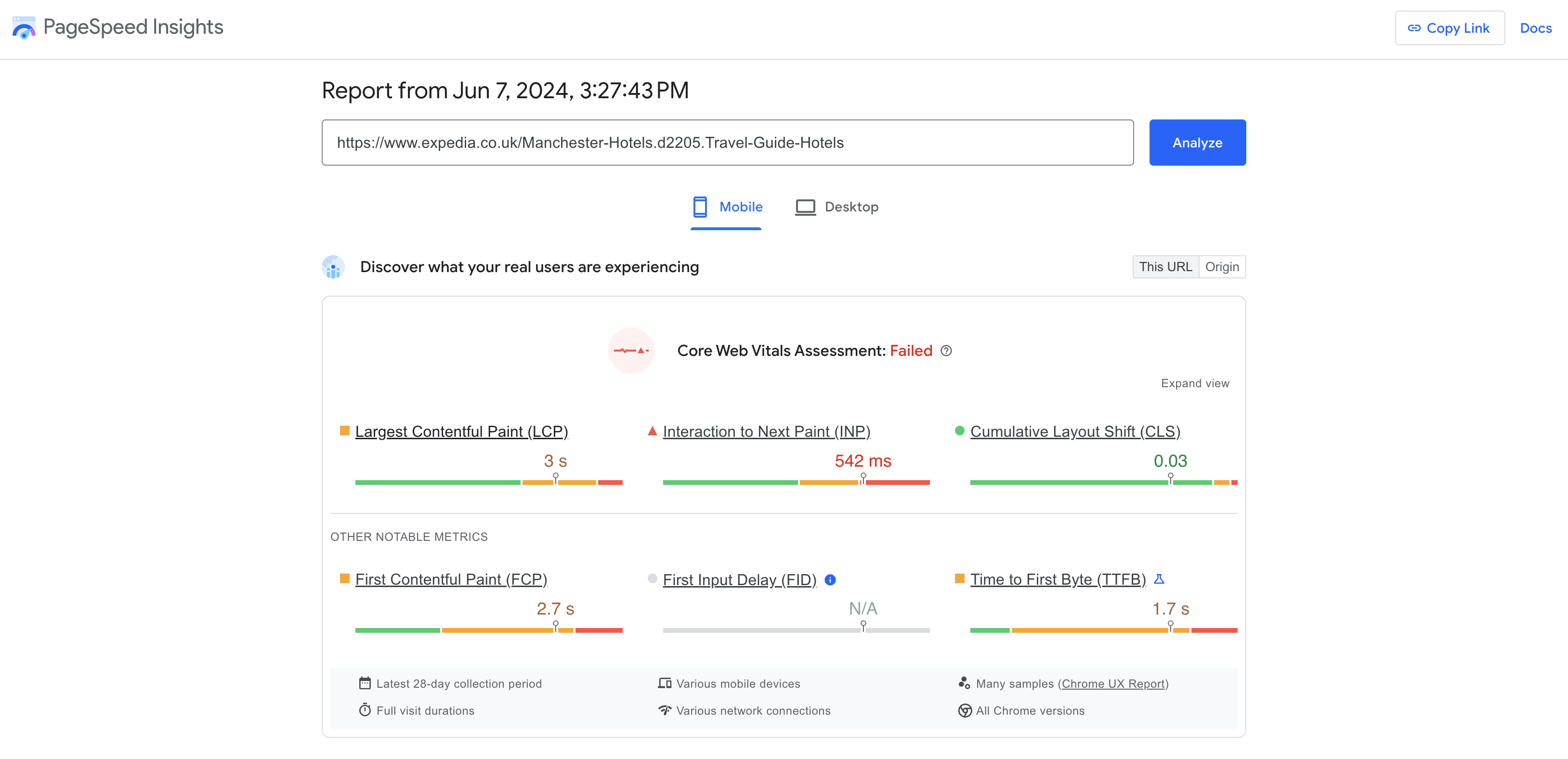
You’ll then see an overview of Core Web Vitals metrics (LCP, INP and CLS), as well as other key metrics.
But most importantly, you’ll see specific recommendations based on what the main issues are, allowing you to prioritise these:
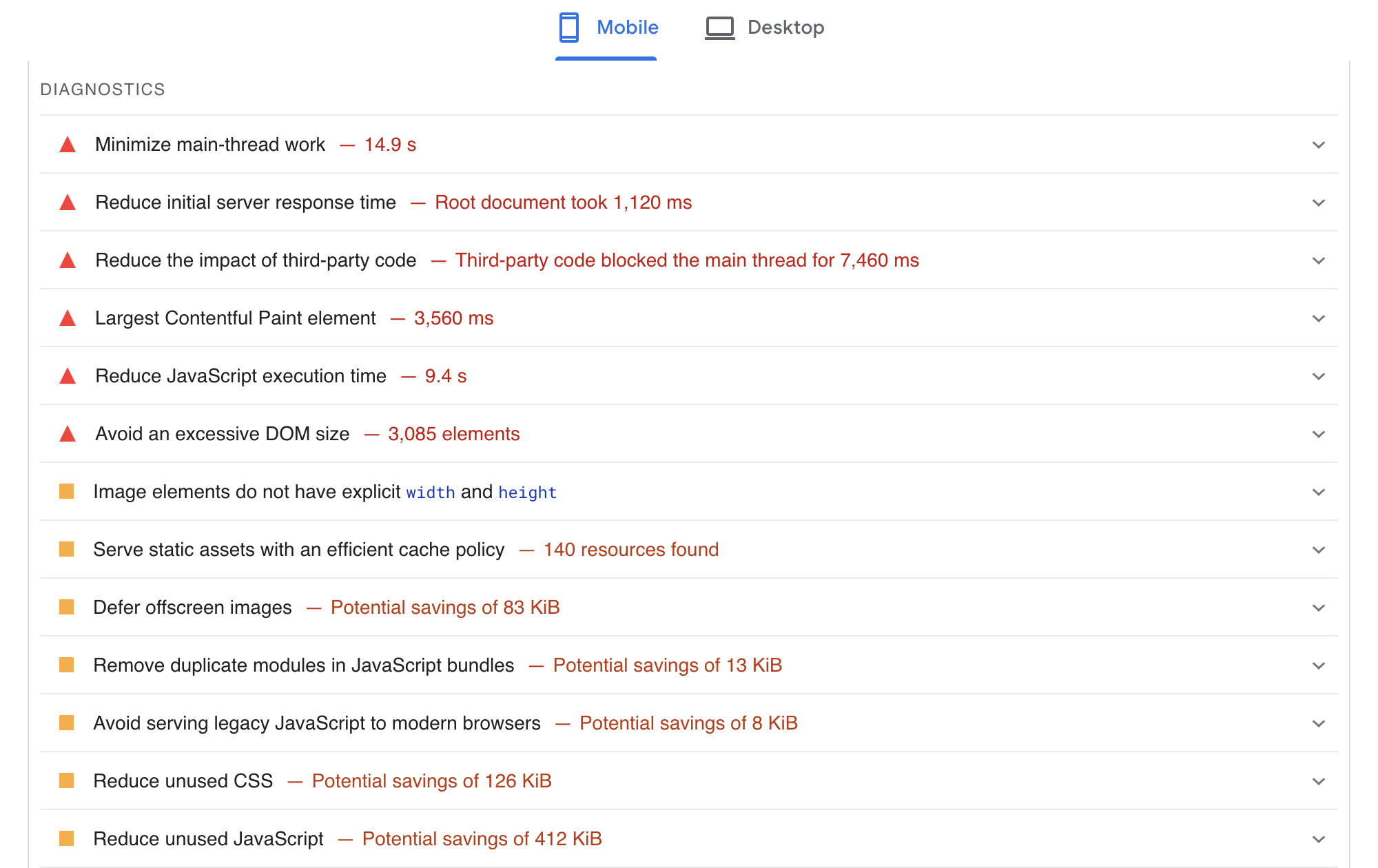
Whilst there are lots of things that could contribute to improving Core Web Vital scores, here’s a look at some of the most common areas:
Image Optimisation
Travel websites often feature high-quality images and videos showcasing destinations, accommodations, and experiences. However, if not optimised properly, these media files can significantly slow down your site.
Image optimisation is often the best place to start to improve PageSpeed and Core Web Vitals.
- Compress Images: Use tools like TinyPNG or ImageOptim to reduce the file size of images without compromising quality, or if your site is on WordPress, with plugins such as EWWW Image Optimizer.
- Use Next-Gen Formats: Implement next-gen image formats like WebP, which offer better compression and quality.
- Lazy Loading: Implement lazy loading for images and videos so that they only load when they enter the user’s viewport.
Minimise JavaScript and CSS
Excessive JavaScript and CSS can delay page rendering and negatively impact Core Web Vitals. It’s also possible for JS to block rendering.
Here’s a quick rundown on where to consider starting:
- Minify and Compress: Minify your JavaScript and CSS files to reduce their size.
- Defer Non-Critical JS: Defer the loading of non-essential JavaScript until after the main content has loaded.
- Inline Critical CSS: Inline critical CSS to ensure that the above-the-fold content loads quickly.
Improve Server Response Time
A slow server response time can hinder your site’s performance and user experience. Here’s how to improve this:
- Use a Content Delivery Network (CDN): CDNs distribute your content across multiple servers worldwide, reducing latency and improving load times for users regardless of their location.
- Optimise Server Configuration: Ensure your server is configured for optimal performance. This might include upgrading your hosting plan or using a faster server technology. You might need to speak to your host or developer, here.
- Implement Caching: Use browser caching and server-side caching to store frequently accessed data, reducing the need for repeated server requests.
Just remember, though, that Core Web Vitals and PageScore aren’t major ranking factors, and you need to consider these alongside your competitors’ scores. Check out Semrush’s guide to learn more about improving these metrics.
HTTPS
No website should launch without being on HTTPS (rather than HTTP), but it’s always worthwhile to remind people of this.
To implement HTTPS, obtain an SSL certificate from a trusted Certificate Authority (CA) and configure your web server to use it. In most cases, this can easily be done through your hosting provider.
Be sure to update all internal links and references to use HTTPS, and set up 301 redirects from the HTTP to HTTPS versions of URLs.
Browsers like Chrome mark non-HTTPS sites as “Not Secure,” making HTTPS something that users have come to expect as a baseline from any site, and it’s something that has been considered a ranking signal by Google since 2014.
HTML & XML Sitemaps
Sitemaps are an essential but often overlooked part of technical SEO, especially HTML ones, providing a roadmap for search engines and users to navigate your sit effectively.
There are two primary types of sitemaps you should focus on: HTML and XML. Each serves a different purpose and contributes uniquely to your growth strategy. It shouldn’t be the case of having one or the other, your site needs both.
HTML Sitemaps
An HTML sitemap is a page on your site that lists all the important pages.
Simple, right?
It helps visitors quickly find the information they are looking for, improving their overall experience.
For travel sites especially, an HTML sitemap can guide users to key sections such as destinations, travel tips, accommodation options, and blog articles.
- User Navigation: HTML sitemaps enhance user experience by providing a clear overview of your website’s structure. This is particularly useful for travel sites with extensive content, ensuring visitors can easily locate specific pages.
- SEO Benefits: Although primarily for users, HTML sitemaps also help your SEO efforts by making your site more accessible and deeper pages easier to crawl. A well-structured HTML sitemap can help distribute link equity throughout your site, improving the visibility of these deeper pages.
XML Sitemaps
An XML sitemap is designed for search engines, listing all the URLs on your site and providing information about each URL, such as the last modified date and its importance relative to other URLs. This helps search engines crawl your site more effectively and for new pages to be discovered.
- Search Engine Indexing: XML sitemaps ensure that search engines discover all the pages on your website, including those that might be hard to find through internal linking alone. For travel websites with numerous pages on different destinations, activities, and services, an XML sitemap is crucial for comprehensive indexing.
- Crawl Efficiency: By providing a clear map of your site’s structure, XML sitemaps help search engines crawl and index your pages more efficiently. This can lead to quicker updates in search results, reflecting new content or changes on your site.
- Priority and Update Frequency: XML sitemaps allow you to signal the importance of different pages and how often they are updated. For example, a travel blog with frequent updates can have its pages marked with higher update frequency, ensuring search engines revisit them regularly.
Your site needs both an HTML and an XML sitemap, and these should be updated automatically when publishing (or removing) content.
Handling JavaScript
Handling JavaScript correctly is key to ensuring that travel websites aren’t being held back by this on the SERPs. JavaScript can present several challenges for SEO if not properly managed, yet is one of the most common issues we find when auditing sites.
Here’s a more detailed look at how to effectively handle JavaScript from an SEO perspective.
The Impact of JavaScript on SEO
JavaScript can create dynamic and engaging user experiences, but it also poses potential SEO problems. Search engines need to crawl and index the content of your site, and if JavaScript is not handled properly, it can hinder this process.
Here’s how Google crawls, renders and indexes JavaScript:
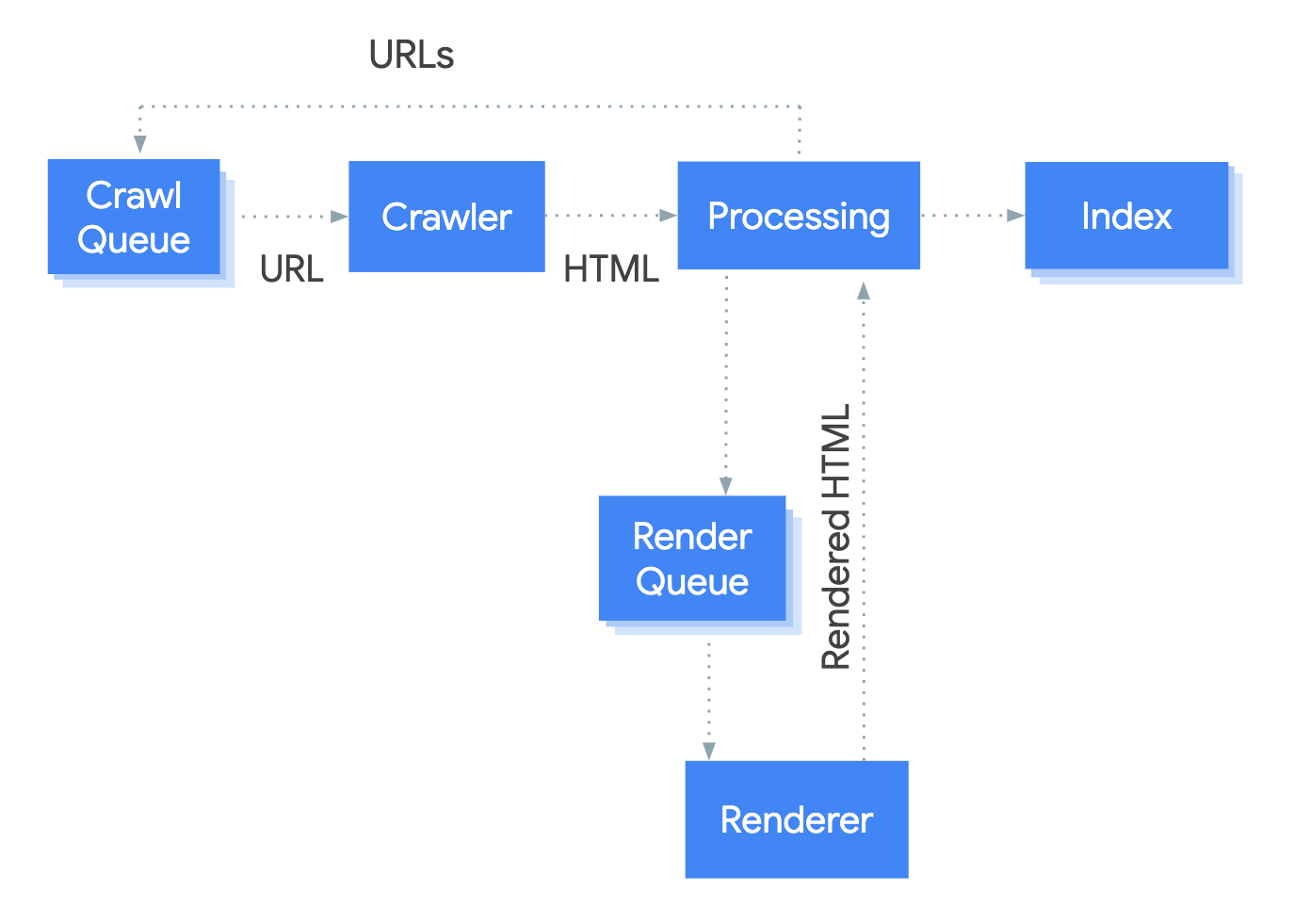
Rendering Methods: Client-Side vs. Server-Side
There are two primary methods for rendering JavaScript content that sites can use:
Client-Side Rendering (CSR): In CSR, the browser executes JavaScript to generate the content. This approach can delay the rendering of content for search engines because the HTML received by the crawler is incomplete, relying on JavaScript to fill in the details. This delay can negatively impact SEO as search engines may struggle to index the dynamically generated content.
Server-Side Rendering (SSR): In SSR, the server processes JavaScript and sends a fully rendered HTML page to the browser. This ensures that search engines receive the complete content without needing to execute JavaScript, which helps in proper indexing and better SEO performance.
JavaScript Best Practices for Travel Websites
Travel websites often rely on dynamic content, meaning that implementing the right rendering strategy is important to ensure this content is accessible to search engines.
- Implement Server-Side Rendering (SSR) or Hybrid Rendering:
- SSR can significantly improve SEO by ensuring that search engines can easily crawl and index your content. For travel websites with a lot of dynamic content, combining SSR with CSR (Hybrid Rendering) can provide the best of both worlds—improved SEO and a responsive user experience.
- SSR can significantly improve SEO by ensuring that search engines can easily crawl and index your content. For travel websites with a lot of dynamic content, combining SSR with CSR (Hybrid Rendering) can provide the best of both worlds—improved SEO and a responsive user experience.
- Dynamic Rendering for Content-Rich Pages:
- Services like Prerender.io can detect when a search engine bot visits your site and serve a pre-rendered version of the page, while regular users receive the standard JavaScript version. This method ensures that all your content is indexed correctly without sacrificing the interactive experience for users.
By carefully choosing and implementing the appropriate JavaScript handling techniques, you can ensure that dynamic content is fully accessible to search engines, thereby improving their chances of ranking higher.
Optimising for Google Discover as a Travel Brand
Google Discover is a personalised content feed that appears on mobile devices, delivering articles, videos, and other forms of content based on users’ interests and browsing habits.

For travel brands, this presents a unique opportunity to reach potential travellers who might not be actively searching for travel content but are open to inspiration and discovery. Remember that ‘dreaming’ micro moment?
Optimising for Google Discover requires an approach that combines engaging content creation, strategic use of visuals, and leveraging SEO best practices, but it’s one worth investing the effort into optimising for.
Content is at the heart of any successful Google Discover strategy, and for travel brands, this means creating visually rich, informative, and inspirational content that aligns with what Discover places preference on.
In Google’s own words about Discover optimisation and increases the chances of appearing, Google gives the following advice:
- Use page titles that capture the essence of the content, but in a non-clickbait fashion.
- Include compelling, high-quality images in your content, especially large images that are more likely to generate visits from Discover. Large images need to be at least 1200 px wide and enabled by the max-image-preview:large setting, or by using AMP. Avoid using a site logo as your image.
- Avoid tactics to artificially inflate engagement by using misleading or exaggerated details in preview content (title, snippets, or images) to increase appeal, or by withholding crucial information required to understand what the content is about.
- Avoid tactics that manipulate appeal by catering to morbid curiosity, titillation, or outrage.
- Provide content that’s timely for current interests, tells a story well, or provides unique insights.
Articles should be well-written and offer value, whether through travel guides, tips, itineraries, or personal stories, and it’s important to tap into trending topics and seasonal interests to align with what potential travellers might find interesting and inspiring.
As a heads up, though, it’s informational and inspirational content that’s most likely to appear in Google Discover. This means guides and the like are far more likely to appear here than hotel listing pages.
But for a travel brand, it’s just another reason why investing in inspirational and informational content is so important as part of your wider SEO strategy.
Free Booking Links on Google for Hotels & Holiday Rentals
Google offers Free Booking Links to help hotels and holiday rentals to get in front of potential guests without the cost of traditional paid advertising. Of course, I’d strongly recommend that any hotel or rental at least tests Google Hotel Campaigns in Google Ads as a way of driving additional exposure and bookings. But we’re looking at SEO, here.
This initiative allows properties to appear in Google’s Hotel Search results, providing direct links to their booking pages. By leveraging free booking links, hotels and holiday rentals can increase direct bookings, ultimately improving their bottom line.
Free Booking Links appear alongside paid ads in Google’s Hotel Search results.
These links direct users to the hotel’s or rental’s own booking site, allowing them to book directly with the property. This reduces the commission fees typically associated with third-party booking platforms and allows properties to establish a direct relationship with their guests.
To participate, hotels and holiday rentals need to be connected to a Google-approved connectivity partner that provides real-time availability and pricing data, as well as meeting listing criteria.
One of the main advantages of leveraging free booking links is the potential to drive more direct bookings, which can significantly reduce acquisition costs as a hotel and holiday rental operator.
Direct bookings allow properties to retain full control over the guest experience, from the initial booking through to post-stay communications. Additionally, let’s not forget that free booking links help level the playing field, giving smaller and independent properties a chance to compete with larger hotel chains and OTAs in Google’s Hotel Search results.
You can learn more about how to set this up in these guides:
Measuring Travel SEO Success
If you’re investing in your travel site’s organic growth, you need to know how to track this and what success looks like.
But it’s important to be aware that measuring and reporting on success isn’t just about understanding your ROI.
Not at all.
It’s as much about being able to identify what is and isn’t working so that you can double down on those things that are driving growth and shift up your strategy when you’re not seeing the impact you expected.
So what metrics should you be tracking?
- Organic Bookings / Revenue: The ultimate measure of travel SEO success is bookings and revenue. Track the number of bookings and revenue generated from organic search traffic, with this directly reflecting the financial impact and ROI of your SEO efforts.
- Organic Traffic: Monitor the number of visitors visiting your site from organic search. Google Analytics (GA4) can help you track this.
- Keyword Rankings: Track how your priority keywords are ranking on the SERPs. Use tools like SEMrush or Ahrefs to set up rank tracking, or go for a specific tool like SE Ranking, Accuranker or SEO Monitor to do this.
- Organic Impressions: Measure how often your site appears in search results as impressions in Google Search Console. Tracking impressions and seeing an increase here is often an early indicator of growth.
It’s not just about tracking these things, though. What matters is how you use this data.
Analyse these metrics on a regular basis to identify trends and patterns. If certain types of content or specific tactics are driving an increase in traffic and bookings, double down on these and focus more resources on those areas.
Conversely, if some efforts clearly aren’t having an impact on results, shift your strategy.
There’s nothing wrong with pulling back on something that’s not working.
Regularly reviewing and understanding your SEO metrics helps you to make informed decisions, focusing your efforts on continuous growth and improvement in your site’s organic performance.
SEO: A Growth Engine for Travel Websites
Investing in SEO is a must for travel brands aiming to diversify their marketing efforts and leverage the huge potential for traffic and bookings that can come from search engines. And what we’ve seen is that even mid-tier travel websites can attract significant non-branded organic traffic, translating to high-value bookings. The potential ROI from organic search is immense, making SEO an essential growth channel that travel marketers shouldn’t ignore.
But a successful SEO strategy must be tailored to the specific needs and goals of every travel brand, whether it’s an OTA, boutique hotel, or large resort group. This involves understanding how to pull the right levers across technical SEO, content and link building to achieve results.
The key to leveraging SEO lies in understanding and navigating the unique challenges of the travel industry, from competing against OTA giants and Google itself to addressing seasonality and lengthy customer journeys. But yy focusing on creating valuable, well-structured content, building strong technical foundations, and earning high-quality backlinks, travel brands can enhance their visibility and drive organic growth.
Ultimately, SEO is not just a marketing tactic but a growth engine for travel websites, offering a scalable and sustainable way to attract, engage, and convert searchers into guests. And as the competitive landscape continues to evolve, staying ahead with a strategic and well-executed SEO strategy will be crucial for travel brands aiming to thrive in the market.
Travel SEO FAQs
Whilst there’s no denying the fact that OTAs own the SERPs for many queries, that doesn’t mean to say that individual hotels can’t perform on the SERPs.
You just need to think carefully about how you can differentiate and where you can, and can’t, win.
Run a search for a keyword like “hotels in London” and you won’t find an individual hotel’s website until position #16. The results before these? Mostly OTAs.
An individual hotel isn’t going to rank for this term anymore.
Get more granular, though, and search for “family-friendly hotel in Fitzrovia”, and you’ll find a handful of individual hotel listings on the first page of the SERPs.
To compete against the OTAs, spend time analysing the SERPs to understand how many other sites that are comparable to yours rank. This should give you an indication as to where you can, and can’t, win.
Outside of this, integrate local SEO to appear on the map listings into a wider digital strategy.
Travel brands can leverage user-generated content (UGC) by encouraging customers to share their travel experiences, reviews, photos, and videos.
UGC is a proven way to demonstrate E-E-A-T given that this is as much about what other people say about you as you say about yourself, as well as the fact that bringing the experience of people who’ve been to a place is so important for travel SEO success.
But it’s not just about SEO. UGC is an incredibly effective way to drive engagement on social and even for use in paid ads, as well as acting as social proof and helping to convert visitors into bookings.
Earning high-quality backlinks is crucial for improving a travel website’s search engine rankings and driving organic traffic. Here are some effective strategies to earn backlinks as a travel brand:
1. Create Exceptional Content
Produce informative, engaging, and visually appealing content that provides value to your target audience and that publishers want to cite and link to from their own content. This could include travel guides, destination reviews, itinerary suggestions, or tips and advice for travellers. High-quality content is more likely to be shared and linked to by other websites and influencers in the travel industry, but content alone is usually not enough; you need a distribution strategy.
2. Digital PR
Pitching to the press and leveraging a mix of expert insights and industry reports and studies, both reactively and proactively, is maybe the best way to earn links as a travel brand. Why? Because digital PR delivers more than just links, also getting you in front of wider audiences, increasing your authority and reputation and driving referral traffic.
3. Broken Link Building
Use tools like Ahrefs to find broken links on authoritative travel websites. Reach out to the website owners and suggest replacing the broken links with relevant content from your website. This strategy can be highly effective as website owners are often eager to fix broken links, but you need to make sure your content is worth linking to.
4. Leverage Local Partnerships
Collaborate with local businesses, attractions, or tourism boards in your target destinations. Offer to create content or provide resources in exchange for a backlink from their website. This can be mutually beneficial, as you gain a valuable backlink, and they receive high-quality content for their audience.
Remember, earning high-quality links is an ongoing process that requires consistent effort and a focus on creating valuable content and building relationships within the industry. Additionally, it’s essential to avoid any unethical or spammy link-building practices, as these can result in penalties from search engines.
Despite what you might have heard, you shouldn’t focus your efforts on publishing to a schedule of X pieces of content per week or month.
Nor is the myth that ‘the more content you publish, the more Google will like you’ true.
Should you build out a content strategy and regularly publish content? Yes, absolutely.
But you need to focus on quality over quantity.
Look at your resources and determine how long you can dedicate as a team to creating content each month. Then put together a content strategy and work through it, focusing more on ensuring each piece you create is high quality rather than on the volume of output or pieces published.
Remember, it’s better to put your effort into one piece that ranks and drives traffic than five that get no traffic.
You should never adopt an approach of ‘publish and forget.’
If you want your content to keep ranking and performing long-term, you’re going to need to keep it up-to-date. Things change, especially in travel. New hotels, resorts or attractions open. Others close. Destinations become popular. Prices change. And that’s just a few things.
As a general rule, I’d always recommend setting reminders to revisit, check the facts and update content every six months after publishing. Sometimes, though, you’ll want to do this more frequently if you know things change more often.
Always keep in mind the resources needed to keep content updated. One mistake I see made time and time again is not allocating the time to go back and update.
Remember, this isn’t optional if you want your content to keep performing.
Travel SEO can work as an integrated strategy with other digital channels to drive growth.
Here’s how:
Integrating SEO and PPC
Paid advertising platforms like Google Ads can complement your SEO efforts by driving immediate traffic and conversions. SEO data can inform paid ad campaigns by:
– Identifying high-value keywords to bid on for paid search ads.
– Creating targeted ad campaigns for locations or services that rank well organically to maximise visibility.
– Using high-performing organic content as inspiration for ad copy and landing pages.
Integrating SEO and Retargeting
Retargeting, also known as remarketing, is a powerful technique that allows travel businesses to re-engage with website visitors who didn’t convert on their initial visit. And given the nature of travel, and the fact that it’s almost always a multi-step journey that begins with extensive research, this means it’s a channel you can’t ignore. By combining retargeting traffic that first lands on informational or inspirational content via organic search with offers and deals, travel companies can create highly targeted and relevant campaigns that drive conversions.
Integrating SEO and Email Marketing
All of the blog and guide content that you’re creating as part of your strategy? That can be a powerful asset for email marketing campaigns. By distributing this content through email newsletters, you can make the content work harder and drive an ROI from other channels, too.









